

Item added to your cart
- Share on Facebook Opens in a new window.
- Tweet on Twitter Opens in a new window.
- Pin on Pinterest Opens in a new window.
Calligraphy: Exploring Its Rich History, Origins, and Multifaceted Uses
Calligraphy is a timeless art that captivates people for centuries. From elegant handwritten letters to intricate designs, calligraphy is the art of beautiful writing. But what exactly is calligraphy? In this article, we'll explore calligraphy - its history, techniques, and diverse styles. Whether you're a beginner or an experienced calligrapher, discover the exquisite artistry and meticulous craftsmanship of this ancient form.
What Is Calligraphy: History, Origins and Uses
How to write calligraphy: step-by-step, calligraphy vs cursive: what’s the difference, how to use a calligraphy pen: step-by-step, what is calligraphy.
Calligraphy is the art of writing beautifully. It involves using specific tools and techniques to create elegant and visually appealing letters and designs. "Calligraphy" comes from the Greek words "kallos," meaning beauty, and "graphein," meaning to write.
Origins Of Calligraphy
Calligraphy finds its origins in ancient civilizations like Egypt and Mesopotamia. These societies created their own unique writing systems, and calligraphy transformed writing into an artistic expression.
In Egypt, hieroglyphics served as a form of calligraphy, featuring intricate symbols and designs carved into stone. Hieroglyphics conveyed both meaning and beauty, not just writing.
In Mesopotamia, cuneiform script was developed, which involved using a stylus to make wedge-shaped impressions on clay tablets. This script was used for a variety of purposes, including administrative records and religious texts. The cuneiform script evolved over time, becoming more sophisticated and aesthetically pleasing.
In China, calligraphy has a long and rich history. Chinese calligraphy is considered one of the highest forms of art in Chinese culture. It involves using a brush and ink to create strokes and characters with varying thickness and rhythm. Chinese calligraphy goes beyond mere writing. It is a captivating form of expression that conveys emotions and the exquisite beauty of characters in a meaningful way.
What Are The Different Types Of Calligraphy?
Different Styles and Types of Calligraphy:
- Western Calligraphy :
This style includes various scripts such as Gothic, Italic, Uncial, and Copperplate. Each script has its own unique characteristics and historical significance.
- Chinese Calligraphy :
Chinese calligraphy encompasses multiple styles, including Regular Script, Running Script, Cursive Script, and Seal Script. Each style emphasizes different strokes and techniques.
- Japanese Calligraphy:
Known as Shodo, Japanese calligraphy is heavily influenced by Chinese calligraphy. It includes different styles such as Kaisho, Gyosho, and Sosho, each with its own rules and characteristics.
- Arabic Calligraphy:
Islamic calligraphy, also known as Arabic script, holds great esteem in the Islamic world. It encompasses different styles like Naskh, Thuluth, and Diwani, each boasting its unique aesthetic charm.
- Indian Calligraphy:
Indian calligraphy encompasses scripts such as Devanagari, Bengali, and Tamil. These scripts are used in various Indian languages and have their own distinct styles and flourishes.
- Persian Calligraphy :
Persian calligraphy, also known as Farsi calligraphy, is based on the Persian script. It includes styles such as Nasta'liq, Shekasteh, and Ta'liq, each with its own elegance and complexity.
- Tibetan Calligraphy:
Tibetan calligraphy is associated with Buddhist art and culture. It involves writing in the Tibetan script, which has its own unique style and beauty.
- Korean Calligraphy:
Known as Seoye, Korean calligraphy has a long history and is deeply rooted in Korean culture. It includes styles such as Kaishu, Gyosho, and Sosho, each with its own characteristics and artistic appeal.
- Hebrew Calligraphy :
Hebrew calligraphy, also known as Jewish calligraphy, is based on the Hebrew script. It includes styles such as Ashurit, Rashi, and Sephardic, each with its own artistic flair and religious significance.
- Latin Calligraphy:
Latin calligraphy refers to the calligraphy of the Latin alphabet. It includes scripts such as Carolingian, Gothic, and Roman, each with its own historical importance and artistic style.
These are a few examples of the various types of calligraphy found worldwide, showcasing its rich diversity. Each style has its own unique characteristics, techniques, and cultural significance. Whether Chinese calligraphy's elegance or Arabic calligraphy's intricacy, it has captivated people for centuries. Calligraphy is a beautiful art form.

Is Calligraphy Still Used In Todays Age?
Yes, calligraphy is still used in today's age. While it may not be as widespread or commonly practiced as it once was, calligraphy continues to be appreciated and utilized in various ways.
One area where calligraphy is still commonly used is in the creation of formal invitations, such as lettering, wedding invitations or event announcements. Many people prefer the elegance and personal touch that calligraphy adds to these special occasions.
In addition to invitations, calligraphy is also used in the design of logos, branding, and packaging. Many businesses and organizations opt for hand-lettered calligraphy to create a unique and distinctive visual identity.
Furthermore, calligraphy is still practiced as a form of artistic expression. Many artists continue to explore and experiment with calligraphy, creating stunning graphics and visual art pieces that blend traditional techniques with contemporary styles. Calligraphy workshops and classes are also available, allowing individuals to learn and develop their own calligraphic skills.
Handcrafted by us, inspired by you and your business

What Tools Are Used For Calligraphy?
Calligraphy is a beautiful art form that involves writing in a decorative and elegant manner. It requires precision, skill, and the right writing instruments to create stunning calligraphic pieces. Here are some of the tools commonly used in calligraphy:
- Nibs: Nibs are the primary tools used in calligraphy . They are metal or plastic tips that are inserted into a pen holder. Nibs come in various shapes and sizes, each producing a different type of stroke. Some popular nib styles include pointed, italic, and broad-edge nibs.
- Pen Holders: Pen holders, also known as pen handles, are used to hold the nib securely. They come in different materials such as wood, plastic, or metal. The shape and weight of the pen holder can affect the control and comfort of the calligrapher. Fountain pens are among the most common and what we are used to seeing in todays age.
- Ink: Calligraphy ink is specially formulated to flow smoothly and evenly. It comes in different colors like black, blue, red, and gold. Ink can be purchased in bottles or cartridges, depending on the preference of the calligrapher.
- Paper: Choosing the right paper is crucial in calligraphy. Smooth and absorbent paper is preferred as it allows the ink to flow smoothly and prevents bleeding. Calligraphy paper usually has a specific weight and texture to enhance the writing experience.
- Brushes: In some calligraphic styles, brushes are used instead of pens. These brushes have soft bristles that allow for more fluid strokes. They are typically used in Eastern calligraphy, such as Chinese or Japanese calligraphy.
- Watercolor or Ink Colors: Calligraphers may use watercolor or colored ink to add vibrancy and variety to their pieces, applying these hues with a brush or pen.
- Ruler or T-square: A ruler or a T-square is used to create straight lines or to measure the spacing between letters or words. This tool helps ensure precision and consistency in the artwork.
- Erasers and correction fluid: Mistakes happen, even in calligraphy. Erasers and correction fluid are used to fix errors or smudges on the paper. Care must be taken when using these tools to avoid damaging the artwork.
- Drying rack: A drying rack is used to place calligraphic pieces to dry. This prevents smudging or smearing of the ink while it dries.
- Illumination materials: In certain calligraphy styles, like Western medieval calligraphy, gold leaf, silver leaf, or pigments are used to decorate and embellish artwork.
Calligraphy can be done with various tools and techniques, not limited to handwriting. These are just a few of the tools commonly used in calligraphy. Calligraphers may also use additional tools or materials depending on their preferred style or technique. Experimentation and personal preference play a significant role in the choice of tools for each calligrapher.
How Has Calligraphy Evolved Over Time?
The Phoenician alphabet was a major milestone in calligraphy, influencing subsequent writing systems. This alphabet introduced a simplified set of characters that could be easily written and engraved, leading to a more efficient and standardized form of calligraphy.
Throughout history, various cultures and regions have contributed to the evolution of calligraphy. The Greeks, for instance, developed the elegant and geometrically precise script known as the Uncial script. The Romans then adapted and refined the Uncial script into the more familiar Roman cursive and capital lettering styles.
During the Middle Ages, calligraphy reached its peak in Europe with the development of Gothic scripts . These scripts showcased elaborate flourishes, intricate letterforms, and high contrast in stroke thickness. This style of calligraphy was widely used for religious manuscripts and illuminated texts.
With the printing press invention in the 15th century, calligraphy declined as printed materials became more accessible and affordable. However, calligraphy continued to be practiced by monks and scribes, who preserved the art form and passed down their knowledge and techniques.
In the 20th century, calligraphy experienced a comeback as artists and designers integrated handcrafted elements into their work. This gave rise to modern calligraphy , blending traditional forms with contemporary design. Today, calligraphy evolves as artists explore new tools, materials, and digital technologies. Some artists have embraced digital tools and software to create digital calligraphy, while others still work with traditional tools and techniques.
The internet and social media have greatly impacted calligraphy's evolution. Artists can now share their work with a global audience, connect with peers, and learn different techniques. Calligraphy has come a long way from its ancient roots and remains a dynamic art form. Whether it's traditional or modern, handcrafted or digital, calligraphy remains a beautiful and expressive way to communicate through the written word.
Step 1: Gather Your Materials
Prior to beginning calligraphy, having the right tools and materials is crucial. Here's what you'll need:
- Calligraphy pen:
Choose a pen that suits your style and comfort. Different types of calligraphy pens include dip pens, fountain pens, and brush pens. Try out different pens to discover the one that suits you best.
The nib is the metal tip of the calligraphy pen that holds and releases the ink. It comes in various sizes and shapes: pointed, broad, or italic. Start with a medium-sized nib for beginners.
Use high-quality calligraphy ink specifically made for calligraphy pens. Select colors to enrich your writing with depth and character.
Choose a smooth and thick paper that can handle the ink without bleeding or feathering. Practice sheets with guideline grids can be helpful for beginners to maintain consistent letter size and spacing.
- Ruler and pencil:
These tools will come in handy for drawing guidelines and maintaining symmetry in your calligraphy.
Step 2: Learn the Basic Strokes
Calligraphy is based on a set of fundamental strokes that form the building blocks of letters and words. These strokes include thin upstrokes and thick downstrokes. Practice these basic strokes to train your hand and get a feel for the pen's pressure.
Step 3: Study Different Calligraphy Styles
Explore different calligraphy styles like Gothic , Italic, Copperplate, and Modern Calligraphy. Research and learn about them to find your preferred one. Each style has unique characteristics and techniques, so understand them before starting calligraphy practice.
Step 4: Practice, Practice, Practice
Calligraphy is a skill that requires practice and patience. Set aside dedicated time each day to practice your strokes and letters. Start by practicing individual letters, then move on to words and phrases. Gradually increase the complexity of your practice exercises to challenge yourself and improve your skills.
Step 5: Focus on Consistency and Precision
One of the key aspects of calligraphy is consistency and precision. Pay attention to the size, spacing, and slant of your letters to create a visually pleasing and balanced piece. Use guidelines to help you maintain consistency in your letterforms.
Step 6: Experiment and Explore
Once you grasp the fundamentals, don't hesitate to explore and experiment. Try different tools, inks, and papers to see how they affect your writing. Experiment with flourishes and embellishments to personalize your calligraphy.
Step 7: Seek Inspiration and Feedback
To improve calligraphy skills, draw inspiration from other calligraphers and artists . Follow calligraphy blogs, join online communities, and attend workshops and classes. Additionally, seek feedback from more experienced calligraphers to help you identify areas for improvement and refine your technique.
Remember, calligraphy is a journey that requires time to develop your unique style. Be patient with yourself and enjoy the process. With consistent practice and a passion for the art, you will see progress and develop your own beautiful calligraphy style.

How Do I Keep My Lines Consistent?
Keeping your lines consistent in calligraphy requires attention to detail and practice. Here are a few tips to help you maintain consistency in your letterforms. First, use guidelines or grid paper to create a visual guide for your letters. This will help you keep your strokes straight and evenly spaced.
Secondly, pay attention to the angle and pressure of your pen or brush. Consistent pressure and angle will result in consistent line thickness throughout your writing. Practice hand lettering vertically and horizontally repeatedly until you develop a consistent and effortless stroke.
Additionally, practice your strokes and letters regularly to build muscle memory and control. Additionally, practice your strokes and letters regularly to build muscle memory and control. Take your time and be patient with yourself. Developing consistency requires time, so don't get discouraged if it's not easy at first. With practice and attention to detail, you will gradually improve and achieve the consistent lines you desire in your calligraphy.
Can Calligraphy Only Be Done In Cursive?
No, calligraphy isn't just limited to cursive. Cursive calligraphy is popular, with numerous ways, styles letterforms to explore. Some calligraphers prefer a more traditional, formal style, while others may experiment with more modern or decorative styles. It depends on your preference and desired look. Experiment with various styles to discover what suits you best. Remember, calligraphy is about expressing your own unique style and creativity.
How Do I Create Curves and Flourishes For My Calligraphy?
- Master the basics:
Before you dive into creating curves and flourishes, it's important to have a solid foundation in basic calligraphy techniques. Make sure you're comfortable with holding your pen properly, applying consistent pressure, and forming basic strokes. Mastering these fundamentals until you feel confident in your abilities.
- Choose the right tools:
To create beautiful curves and flourishes, you'll need the right tools and utensils. A flexible nib is essential for achieving smooth and flowing lines. Experiment with different nibs to find the one that suits your style and preference. Additionally, make sure you have high-quality ink and smooth paper that won't cause any disruptions in your strokes.
- Slow down and take your time:
When it comes to creating curves and flourishes, precision is key. Slow down your strokes and focus on maintaining a consistent speed and pressure. Rushing through the process can result in messy and uneven lines. Remember, calligraphy is all about attention to detail.
- Practice basic curves:
Start by practicing basic curves to get a feel for the motion. Begin with a downward stroke and gradually apply pressure as you move the pen upwards, creating a smooth curve. Repeat this motion several times until you feel comfortable with the movement. Then, try creating curves in different directions, such as upward and diagonal. Remember to maintain a light touch and steady pressure throughout.
- Experiment with flourishes:
Once you've mastered basic curves, you can start adding flourishes to your calligraphy. Flourishes are decorative extensions that can be added to letters or words to enhance their beauty. Start by practicing simple flourishes, such as loops or curls, at the beginning or end of your letters. As you gain confidence, you can experiment with more complex and intricate flourishes. Remember to keep a consistent flow and rhythm as you add these decorative elements.
- Study and learn from others:
Look for inspiration from experienced calligraphers and study their work. Analyze how they create curves and flourishes and try to replicate their techniques. Don't hesitate to experiment and develop your unique style. The more you observe and practice, the better you'll get at creating beautiful curves and flourishes in calligraphy.
What Is Faux Calligraphy?
Faux calligraphy mimics traditional calligraphy using everyday writing utensils like pens and markers. Unlike the traditional version, which needs specialized tools like a dip pen and ink, faux calligraphy can be done by anyone. The term "faux" refers to its imitation of traditional calligraphy. However, this doesn't mean that faux calligraphy is any less impressive or beautiful. Its popularity has grown in recent years because of its easy access and adaptability.
What's The Difference Between Modern Calligraphy and Traditional Calligraphy?
Modern and traditional calligraphy are exquisite forms of the art of writing; however, they exhibit distinct variations.
- Style and Aesthetic:
Traditional calligraphy follows specific letterforms and rules that have been established over centuries. It is often associated with formal and classic designs. On the other hand, modern calligraphy embraces a looser and more contemporary style. It allows for more experimentation and personal expression, often incorporating elements of handwriting and other artistic influences.
- Tools and Techniques:
Traditional calligraphy is typically done with a fountain pen, dip pen or a brush using specific types of ink, such as Indian ink or gouache. The tools and techniques used are often more rigid and structured. Modern calligraphy can be done with various tools like brush pens, markers, or regular pens and pencils. It offers flexibility and room for experimentation with different inks and mediums.
- Rules and Guidelines:
Traditional calligraphy follows rules and guidelines for letterform proportions, spacing, and stroke order. These rules ensure consistency and uniformity in the writing. Modern calligraphy, on the other hand, doesn't have strict rules. It encourages the artist to break free from tradition and incorporate their own unique style.
- Purpose and Application:
Traditional calligraphy is often associated with formal documents, such as wedding invitations, certificates, or important manuscripts. It is commonly used for special occasions or to add a touch of elegance to important written materials. Modern calligraphy is versatile and applicable to various projects and mediums. It can be used in branding, graphic design, personal artwork and worksheets, and even digital media.

Does Knowing Cursive Translate To Knowing Calligraphy?
Knowing cursive does not necessarily translate to knowing calligraphy. While cursive writing may share some similarities with certain calligraphy styles, calligraphy requires specific skills and techniques that go beyond simply connecting letters. Calligraphy involves a greater focus on letterforms, stroke order, and creating consistent and intentional lines.
Knowing cursive can be a helpful foundation for learning calligraphy, it is not a guarantee of proficiency in the art form. Calligraphy requires additional dedication and practice to develop the necessary skills and achieve the desired level of mastery.
Are There Any Unique Effects I Can Incorporate Into My Modern Calligraphy?
Yes, you can incorporate many unique effects into your modern calligraphy. Some popular effects include:
- Bounce lettering: This technique involves adding a playful and dynamic rhythm to your letterforms by varying the height and width of the strokes. It gives your calligraphy a lively and energetic look.
- Flourishes: Flourishes are decorative elements that can be added to the beginning or end of letterforms. They can range from simple curls to elaborate swirls and loops. Flourishes can add elegance and sophistication to your calligraphy.
- Watercolor blending: If you're using watercolor inks or paints, you can create beautiful gradient effects by blending different colors together. This adds depth and dimension to your calligraphy.
- Shadowing: Adding shadows to your letterforms can create a 3D effect and make them appear more visually striking. You can achieve this by using a darker shade of ink or by adding shading with a brush or marker.
- Embellishments: You can add decorative elements such as dots, stars, hearts, or other small illustrations to enhance your calligraphy and make it more personalized.
- Mixing different styles: Modern calligraphy lets you combine various lettering styles, like script, serif, and sans-serif, for unique and visually engaging compositions. Remember, the key to incorporating unique effects into your modern calligraphy is to practice, experiment, and develop your own personal style.
What Are Some Drills I Can Do To Enhance My Calligraphy Skills?
To enhance your calligraphy skills, there are several drills you can practice. These drills focus on improving your letterforms, stroke order, and consistency. One drill you can do is the basic stroke drill, where you repeatedly practice making straight lines, curves, and loops. This helps improve your control over the pen and your ability to create consistent lines.
Another drill is the letterform drill, where you practice writing each letter of the alphabet multiple times, focusing on maintaining consistent size, shape, and spacing. This drill helps you become more familiar with the letterforms and develop muscle memory.
Additionally, you can practice the connecting stroke drill, where you write words or phrases with an emphasis on connecting each letter smoothly and seamlessly. This drill helps improve your flow and transition between letters.
What Is Cursive?
Cursive is a style of handwriting that is characterized by the flowing and connected of joined letters. It is a practical and efficient way of writing, as it allows for faster and more fluid writing compared to print writing. Cursive writing is commonly taught in schools and is often used for everyday writing tasks such as note-taking, writing letters, and completing assignments.
The origins of cursive writing can be traced back to ancient times. It was widely used by the Romans and later adapted and developed by various cultures and civilizations. In the US, cursive writing was once taught in schools. However, its usage and instruction have declined due to the rise of digital communication in recent times.
What's The Differences Between Calligraphy and Cursive?
While calligraphy and cursive both involve handwriting, there are several key differences that set them apart:
- Style: Cursive writing is more practical and utilitarian, focusing on speed and efficiency, while calligraphy is more artistic and decorative, emphasizing precision and visual appeal.
- Tools and techniques: Cursive writing can be done with any writing instrument, while calligraphy typically requires specialized tools such as pens, brushes, and ink. Calligraphy also involves specific techniques such as pressure, thick and thin stroke variations to create different scripts and visual art representations of lettering.
- Purpose and applications: Cursive writing is commonly used for everyday writing tasks, such as note-taking and completing assignments. Calligraphy, on the other hand, is often used for special occasions and formal events, where an elegant and artistic touch is desired.
- Training and skill level: Cursive writing is typically taught in schools and can be learned by anyone with practice. Calligraphy, however, requires more skill and training to master its intricate letterforms and artistic techniques.
Can Calligraphy and Cursive Writing Be Used Interchangeably?
Calligraphy and cursive writing may seem similar at first, but they are distinct forms of writing. While they both involve fluid, strokes and connections each has its own unique characteristics and purposes. Therefore, calligraphy and cursive writing cannot be used interchangeably.
How Do The Two Handwriting Styles Compare In Terms Of Complexity?
In terms of complexity, calligraphy generally requires more time, practice, and attention to detail compared to cursive writing. Calligraphers must learn different scripts and study the characteristics and nuances of each style. They need to master techniques like creating thick downstrokes and thin upstrokes, achieving consistent letterforms, and understanding spacing and layout principles.
Cursive writing, on the other hand, is quickly learned and often introduced at a young age in schools. It focuses on developing a simple, consistent and legible style, as well as maintaining the flow and rhythm of the writing. While cursive writing may not require as much precision and attention to detail as calligraphy, mastering it still requires practice and dedication.
Are There Different Styles Of Calligraphy and Cursive Writing?
Beginning with calligraphy, various renowned styles have emerged from diverse cultures and historical eras. Here are a few notable calligraphy styles:
- Copperplate : This elegant and ornate style of calligraphy originated in England during the 18th century. Copperplate calligraphy is characterized by its slanted and flowing letterforms, which are created using a pointed pen.
- Gothic: Also known as Blackletter, this style of calligraphy originated in medieval Europe. It is recognized for its bold, angular letterforms, which often have intricate details and flourishes.
- Italic: Italic calligraphy is a modern style that emerged during the Renaissance. It is characterized by its slanted, flowing letterforms that have a slight tilt to the right. Italic calligraphy is often used for its legibility and versatility.
- Uncial : Uncial calligraphy originated in ancient Rome and was later adopted by Irish and Scottish monks. It is known for its rounded and curved letterforms, which are often written with a broad-nibbed pen.
These are just a few examples of the numerous calligraphy styles that exist. Each style has its own unique characteristics and history, making calligraphy a rich and diverse art form.
Similarly, cursive writing also has its own styles and variations. Some popular cursive writing styles include:
- Palmer Method: Developed by Austin Palmer in the late 19th century, the Palmer Method is a simplified cursive writing style that focuses on efficiency and legibility. It features rounded and flowing letterforms with a slight slant to the right.
- D'Nealian : Created by Donald Thurber in the 1970s, the D'Nealian style aims to bridge the gap between manuscript printing and cursive writing. It features a combination of print and cursive letterforms, making it easier for young learners to transition from printing to cursive.
- Spencerian: Developed by Platt Rogers Spencer in the 19th century, the Spencerian style is known for its elegant and ornamental letterforms. It features flowing and elaborate curves, making it a popular choice for formal and decorative purposes.
- Zaner-Bloser : Created by Charles Zaner and Elmer Bloser in the early 20th century, the Zaner-Bloser style is widely taught in American schools. It features a simplified and legible cursive writing style with clear letterforms and consistent slant.
What Is a Calligraphy Pen?
A calligraphy pen is a specialized writing instrument that is designed for creating beautiful and decorative lettering. Unlike regular pens, calligraphy pens have a unique nib (the metal tip) that allows for different line widths and styles. These pens are compatible with different types of ink, including traditional ink as well as modern alternatives like markers or brush pens. Calligraphy pens come in different styles like dip pens, fountain pens, and markers, each with unique advantages and characteristics. The choice of pen depends on personal preference and the type of calligraphy you wish to create.
How To Use a Calligraphy Pen
Step 1: Choose the right pen
To start using a calligraphy pen, first, select the one that suits your needs. Take into account factors like the desired calligraphy style, your level of experience, and personal preferences when choosing from various available types of calligraphy pens. Dip pens are great for beginners as they allow for more control, while fountain pens offer convenience and ease of use. Try out various pens to discover the one that feels most comfortable in your hand and achieves the desired results.
Step 2: Prepare your pen
Before using your calligraphy pen, it is important to prepare it correctly. For a dip pen, securely attach the nib to the pen holder, ensuring it is clean and free from residue or ink buildup. If using a fountain pen or marker, make sure it is filled with ink or has a fresh cartridge inserted.
Step 3: Choose your ink
Next, select your ink. Traditional calligraphy ink comes in different colors and is often mixed with water for a thinner consistency. For a dip pen, dip the nib into the ink and let it soak for a few seconds. For fountain pens or markers, refer to the manufacturer's instructions to fill or prime the pen with ink.
Step 4: Hold the pen correctly
Proper grip and posture are essential for achieving clean and precise calligraphy strokes. Hold the pen in a relaxed manner, with your fingers resting lightly on the pen. The nib should be slightly horizontal, for best results aim for a 45-degree angle to the paper, allowing for smooth and consistent ink flow. Position your hand and arm in a way that feels comfortable and allows for controlled movements.
Step 5: Practice basic strokes
Before you start writing letters, it's important to practice basic calligraphy strokes. This will help you get a feel for the pen and develop control over your movements. Start with simple upstrokes and downstrokes, applying varying pressure to create different line widths. Practice curves and loops to achieve fluidity in your strokes. Take your time and focus on consistency and precision.
Step 6: Start writing letters
Once you feel confident with the basic strokes, you can start writing letters. Begin with simple letterforms and gradually progress to more complex ones. Pay attention to the spacing and alignment of your letters, as well as the overall balance of your writing. Practice regularly to improve your skills and develop your own unique style.
Step 7: Clean and maintain your pen
After each use, it's important to clean your calligraphy pen to prolong its lifespan. Rinse the nib with warm water, gently removing any ink residue or buildup. Dry the nib thoroughly before storing it. If you're using a fountain pen, follow the manufacturer's instructions for regular cleaning and maintenance.

When Was The First Calligraphy Pen Used?
The first calligraphy pen was used thousands of years ago in ancient civilizations such as Egypt and China . These early calligraphy pens were typically made from reeds or bamboo and had a split nib that allowed for the controlled flow of ink. Calligraphy has a rich and extensive history. Calligraphy pens have evolved over time, offering a multitude of materials and designs. Today, there is a wide selection of calligraphy pens in various styles and sizes. These pens enable artists and enthusiasts to explore different techniques and create stunning lettering. Irrespective of your expertise, a calligraphy pen has the power to elevate your writing and breathe life into your artistic expression.
What Is The Best Way To Hold a Calligraphy Pen?
Proper technique is crucial for pen-holding. It greatly impacts stroke flow & control. Here is the best way to hold a calligraphy pen.
Start by holding the pen between your thumb and index finger. Place your thumb on one side of the pen and let your index finger rest on the opposite side. The pen should rest just above the first knuckle of your index finger.
Position your hand slightly above the writing base, allowing your pen to glide smoothly across the paper. Your hand should be at a comfortable angle, neither too vertical nor too horizontal. Experiment with different angles to find what works best for you.
Apply gentle and consistent pressure on the pen as you write. Avoid gripping the pen too tightly, as this can lead to tense and rigid strokes. Instead, maintain a relaxed grip that allows for fluid movement.
Ensure that the nib of your calligraphy pen is aligned with the angle of your hand. This will help you maintain consistent strokes and prevent any unintended slanting. Practice keeping the pen angle steady as you write.
When creating strokes, it's important to move your entire arm rather than just your fingers. This promotes fluidity and control in your lettering. Use your forearm and shoulder to guide the movement of your pen, allowing your fingers to relax and remain flexible.
Holding a calligraphy pen correctly takes practice and patience. Set aside dedicated practice sessions to work on your grip and technique. Start with basic strokes and gradually move on to more complex letterforms. With time and practice, you will develop muscle memory and a comfortable grip that suits your unique style.
Remember, there is no one-size-fits-all approach to holding a calligraphy pen. Experiment with different grips and positions to find what feels most comfortable and natural for you. The key is to maintain a relaxed grip and fluid movement to achieve beautiful and precise lettering.
What Is The Best Way To Clean a Calligraphy Pen?
To clean a calligraphy pen, rinse the nib with warm water. Remove any excess ink by running it under the water. Wipe away remaining ink gently with a soft cloth or paper towel. Submerge the nib in a small cup or container filled with warm water. Allow the pen to soak for a few minutes to loosen any dried ink. After soaking, gently agitate the pen in the water to dislodge any stubborn ink particles. Finally, remove the pen from the water and pat it dry with a towel. Make sure to thoroughly dry the nib before reassembling the pen. Cleaning your calligraphy pen regularly will help maintain its performance and prolong its lifespan.
How Do You Achieve Thick and Thin Lines With a Calligraphy Pen?
When it comes to calligraphy, achieving thick and thin lines is essential for creating beautiful and elegant letterforms. The technique used to achieve this effect is called pressure control. Here is how to do it:
- Choose the right pen:
Look for a calligraphy pen that has a flexible nib. These pens are specifically designed to respond to pressure, allowing you to create lines of varying thickness.
- Hold the pen correctly:
Hold the pen at a 45-degree angle to the paper. This angle allows the nib to make smooth contact with the paper, ensuring better control over the thickness of your lines.
- Apply pressure:
Apply firm pressure on the downstrokes and light pressure on the upstrokes. Downstrokes are lines that move downward on paper, while upstrokes are lines that move upward. By pressing down on the nib during the downstrokes, you will create thicker lines. Conversely, by applying lighter pressure on the upstrokes, you will create thinner lines.
- Practice consistency:
Consistency plays a crucial role in achieving the desired effect. Practice maintaining consistent pressure throughout your strokes to create even and smooth lines. Too much pressure can result in blots or smudges, while too little pressure can make the lines appear weak and inconsistent.
- Experiment with speed:
The speed at which you move the pen across the paper can also affect the thickness of the lines you create. By moving the pen slowly, you will have more control and can create thicker lines. On the other hand, moving the pen quickly will create thinner lines. Experiment with different speeds to find the right balance for the desired effect.
Remember, achieving thick and thin lines with a calligraphy pen requires patience and practice. Keep practicing, experiment with different pens and techniques, and soon you'll be creating stunning calligraphy with ease.
How Do I Properly Assemble and Refill My Calligraphy Pen?
Properly assembling and refilling your calligraphy pen is essential for smooth and uninterrupted writing. To begin, ensure you have the necessary components - pen holder, nib, and ink cartridge or converter. Begin by attaching the nib to the pen holder, ensuring a secure fit.
Next, insert the ink cartridge or converter into the pen holder, following the manufacturer's instructions. Gently push it in until you feel it click into place. When using a converter, ensure it's ink-filled before inserting. To refill the pen, dip the nib fully into the ink bottle.
Twist the converter or press the cartridge to draw ink into the pen. Once the pen is filled, remove excess ink, and start writing. Remember to clean your pen regularly to prevent clogging and maintain its performance. Following these steps will ensure that your calligraphy pen is properly assembled and ready for use.
In conclusion, calligraphy is a timeless and adaptable art form that has evolved through history, embracing technological advancements and a global audience. Whether practiced with traditional or digital tools, it continues to capture the essence of written words. By following the outlined steps, individuals can embark on a calligraphy journey, mastering the craft with diligence and creativity. Confidence, tool selection, and dedicated practice are key. Modern calligraphy offers a rewarding avenue for creative expression and collaboration, while cursive writing remains a practical skill. Both cater to diverse interests, making them enjoyable pursuits. Mastery of a calligraphy pen requires patience and practice, and this guide provides comprehensive instructions. With dedication, individuals can unlock their artistic potential and craft captivating calligraphy designs. So, pick up that pen and let your creativity flow onto your chosen canvas through the graceful strokes of calligraphy.
Final Thoughts
Unlock the power of personalized branding with Artlogo . Our expert team specializes in creating stunning handwritten signatures , logos, and business cards that leave a lasting impression. Choose Artlogo for all your personal and professional needs, and make every encounter unforgettable.
- https://www.bl.uk/history-of-writing/articles/a-short-history-of-calligraphy-and-typography&sa=D&source=docs&ust=1693930334821796&usg=AOvVaw0JPwkqI_MFwxKnXLRpV4Ax
- https://www.musicalexpert.org/what-is-western-calligraphy.htm
- https://asiasociety.org/education/chinese-calligraphy
- https://persian.religion.ucsb.edu/resources/caligraphy/
- https://www.jewishvirtuallibrary.org/modern-hebrew-calligraphy
- https://crossroadscalligraphy.com/calligraphy-nibs/
- https://musicmayhemmagazine.com/the-history-of-the-first-world-font/#google_vignette
- https://thepostmansknock.com/what-is-modern-calligraphy/
- https://www.britannica.com/topic/black-letter
- https://learn.podium.school/art/famous-calligraphers/
- https://artltdmag.com/best-calligraphy-inks
- https://www.blissfullyyours.co.uk/blogs/itchy-sketchy/brush-vs-faux-calligraphy-what-should-i-learn-first
- https://www.twinkl.com/teaching-wiki/cursive-handwriting
- https://study.com/learn/lesson/cursive-handwriting-types-styles-examples.html
- https://calligrascape.com/how-to-learn-copperplate-calligraphy/
- https://www.britannica.com/topic/uncial
- https://www.classroomresourcecenter.com/shop-by-program/dnealian-handwriting/
- https://www.zaner-bloser.com/handwriting/zaner-bloser-handwriting/index.php
- http://www.madehow.com/Volume-7/Fountain-Pen.html
- https://curtisward.com/what-is-a-dip-pen
- https://www.calligraphy-skills.com/traditional-pigments.html
- https://www.penheaven.com/blog/the-greatest-pen-inventions-of-all-time
Get a multipurpose signature logo to represent you
800+ Reviews on Trustpilot
Every person signs a large number of documents, send thousands of emails or active in social media during their lifetime. Artlogo's mission is to create your eye-catching signature that makes You and Your name unqiue and helps you stand out.
What do our clients say about Artlogo
Gerry sandusky (communications coach).
I was looking for a personal touch because people follow people.
Danielle Ruban (Entrepreneur)
I'm so happy with the logo. It really represents me.
Shawn Brown (President & CEO)
Product they delivered far exceeded my expectations.
The Stat (Photography)
I was 100% happy with for the first time.
Paul Feith (CEO & Entrepreneur)
I must say, I am impressed
Gabriel Eriksson (IT Java-Developer Consultant)
I was amazed. I was like Aahhhhh!!!
Matt Heilman (Real Estate)
I got awesome new logo. Artlogo did a great job!
Steve Taubman (Realtor, Speaker and Award-Winning Author)
They are extremely easy to work with.
Chantal Diez (Art & Design)
I am confident now to launch my business
Troy Fears (CEO of a Museum)
All I can say is "Wow"! Artlogo nailed it.
Anand Jansen (HR Development & Strategy)
I was bit skeptic when I ordered...
Brian Ames (Co-owner of Dance Studio)
It's my second order from Artlogo!
Joseph Taylor (Media Specialist)
Fantastic job. I absolutely love it!
Edward Paul Reyes (Attorney)
It’s given me absolute confidence. I wouldn't be without it.
Anton Bucher (Store Owner)
I think that's ridiculously cool
Leave a comment
- Choosing a selection results in a full page refresh.

Calligraphy 101 – The ULTIMATE Guide For Beginners
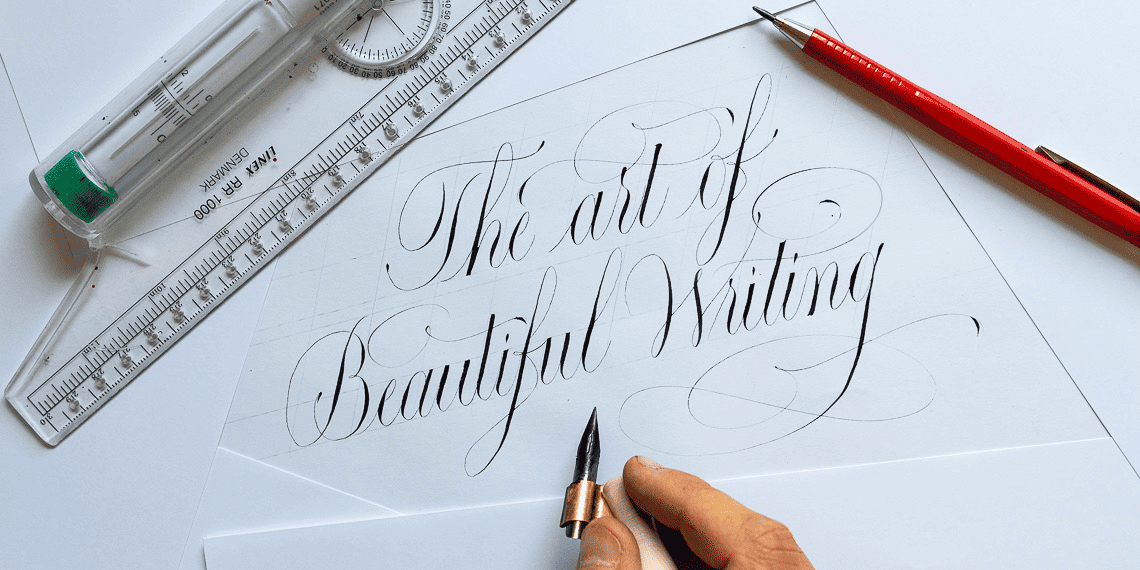
This post and the photos within it may contain affiliate links. If you purchase something through the link, I may receive a commission at no extra charge to you.
If you want to learn how to start with calligraphy, you’ve come to the right place.
On this page, you will find everything you need to know about what calligraphy is and how to get started with it.
Whether you’re just starting with calligraphy or have been practicing for a while, this page contains many valuable resources to help you learn and improve your calligraphy skills.
Let’s get started!
Note – This page is consistently updated as I create new helpful resources.
What is calligraphy? In simple words.
Calligraphy is a visual art form that creates decorative handwriting using specific tools.
In other words, calligraphy is the art of beautiful writing.
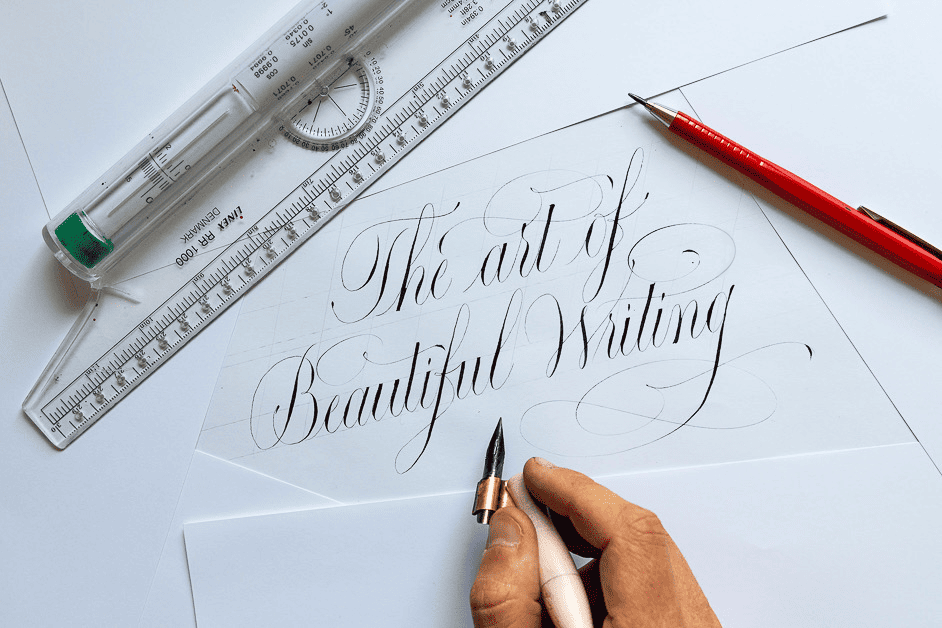
However, calligraphy is a broad term that encompasses a wide variety of styles and cultures from every corner of the globe.
We can primarily divide calligraphy into different cultures around the world.
To name a few –
- Western calligraphy (the Latin alphabet)
- Chinese calligraphy
- Japanese calligraphy
- Arabic calligraphy
- Indian calligraphy
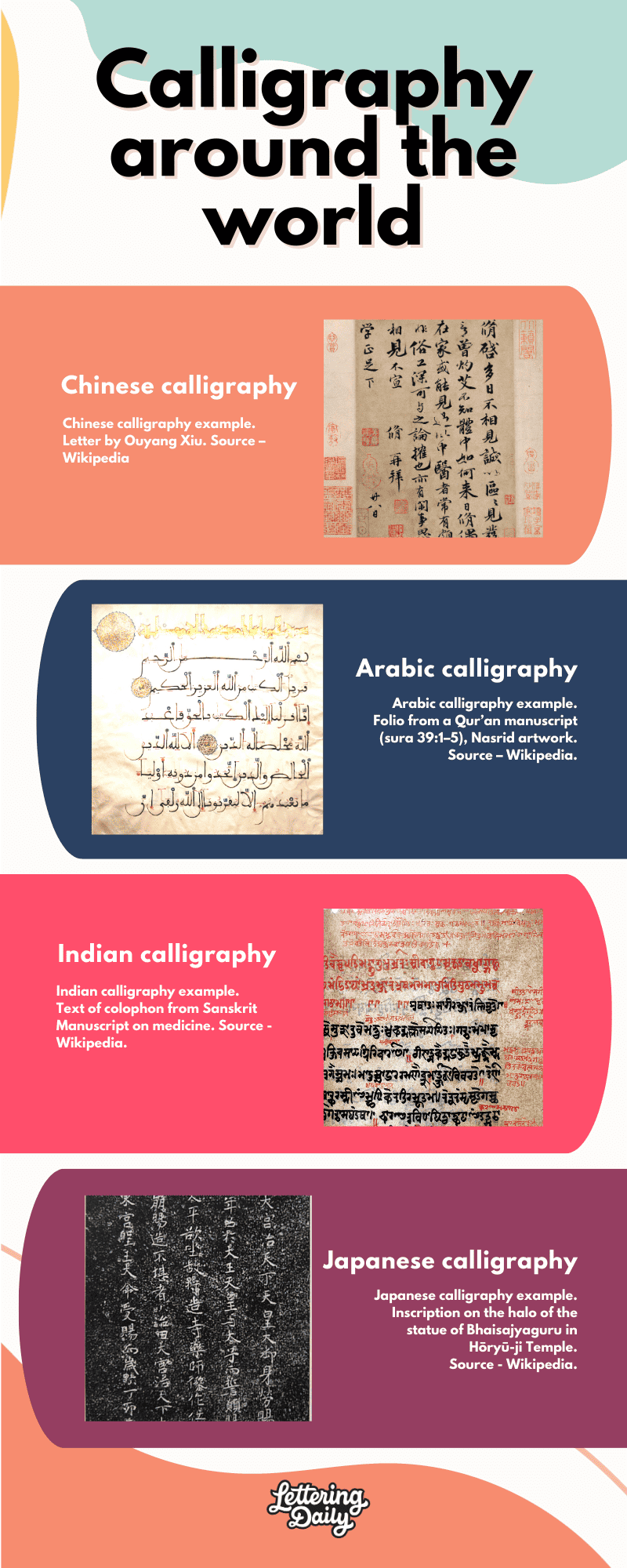
Note: Despite the art of beautiful writing being present in many cultures across the globe, I focus primarily on studying, practicing, and teaching Western calligraphy and the Latin alphabet.
What are some key features of calligraphy?
It’s important to distinguish between handwriting (including cursive) and calligraphy.
It is common for the untrained eye to see these two as the same.
With that in mind, here are a few key features of calligraphy.
1. Variation in stroke thickness.
Calligraphy can be done with any writing tool; however, there are specific tools dedicated to calligraphy.
The two most common tools are broad-edged and pointed pens.
These tools are specific for calligraphy because they can create stroke thickness variations.
The broad-edged nib achieves that by keeping the pen at a consistent angle (and the direction of movement), whereas the pointed nib achieves that by adding/removing pressure as you write.
The contrast in stroke thickness that these tools can create while you write is one of the most prominent features of calligraphic letters.
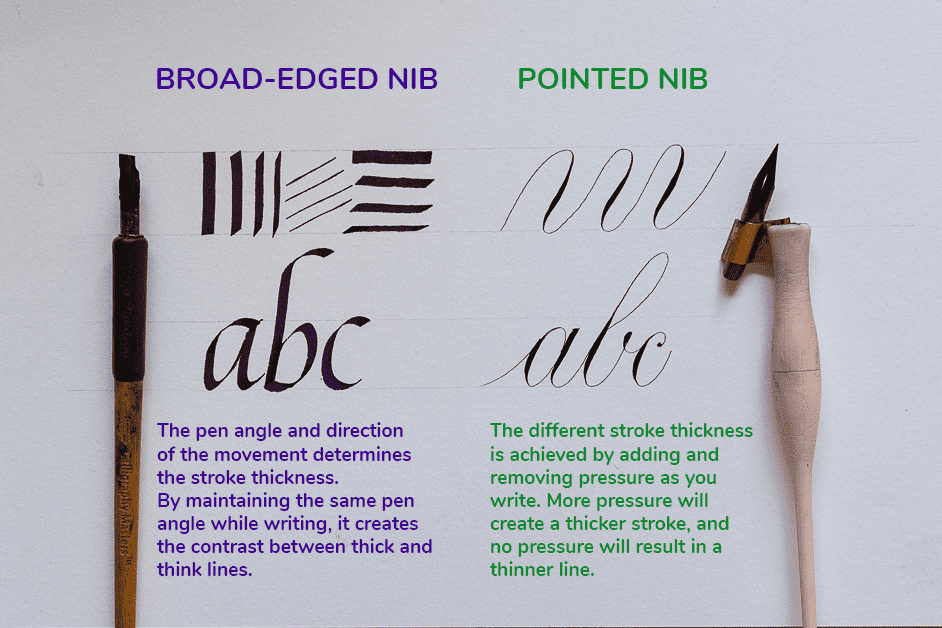
2. Letterform proportions and structure.
A specific proportion and structure of letters are maintained throughout the writing.
This is particularly important for traditional calligraphy scripts.
For example, Blackletter calligraphy is created with a broad-edged tool.
The angle of the pen is held at a 45-degree angle.
The letters are completely vertical, and they are proportionally sized according to the width of the pen.
That’s why we use the pen width as a measuring unit when it comes to broad-edged (flat tip) calligraphy styles.
These are just some of the “rules” you need to follow to create this particular style of calligraphy.
Calligraphy guidelines allow us to focus on creating beautiful and consistent letterforms.
Without calligraphy guidelines, you would have to guess and eyeball all the sizing and proportions, and it would make the whole process much more difficult.
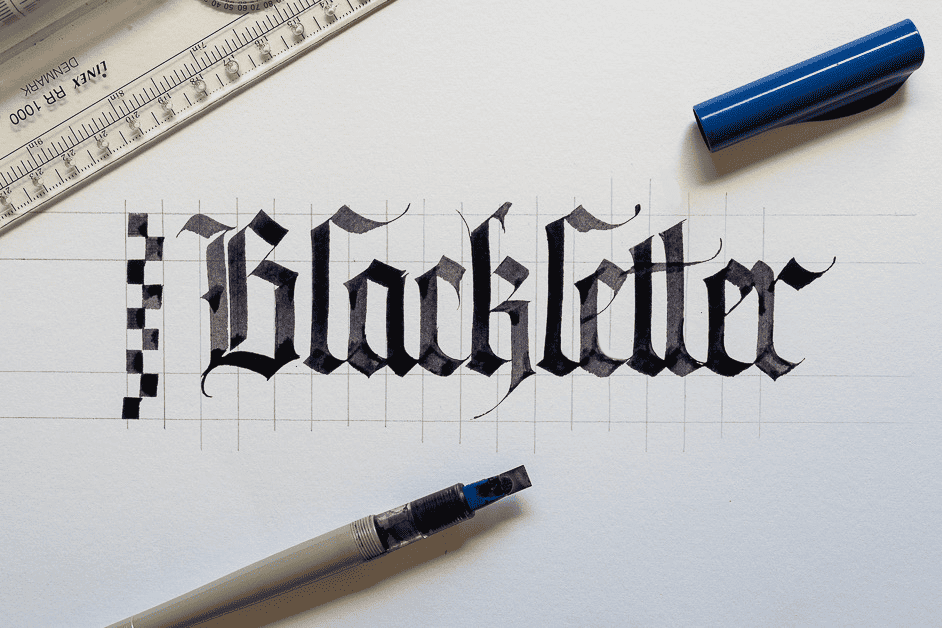
3. Consistency and uniformity.
Calligraphy places great emphasis on consistent and uniform letterforms.
Achieving consistent stroke widths, angles, spacing, rhythm, etc., and overall letter shapes throughout a piece of writing is essential for creating a cohesive and visually pleasing result.
In the example below, I am using two different colored brush pens along with the basic calligraphy strokes to write out the word minimum.
I am focused on maintaining consistent spacing, slant, space within the letters (also known as counters), etc.
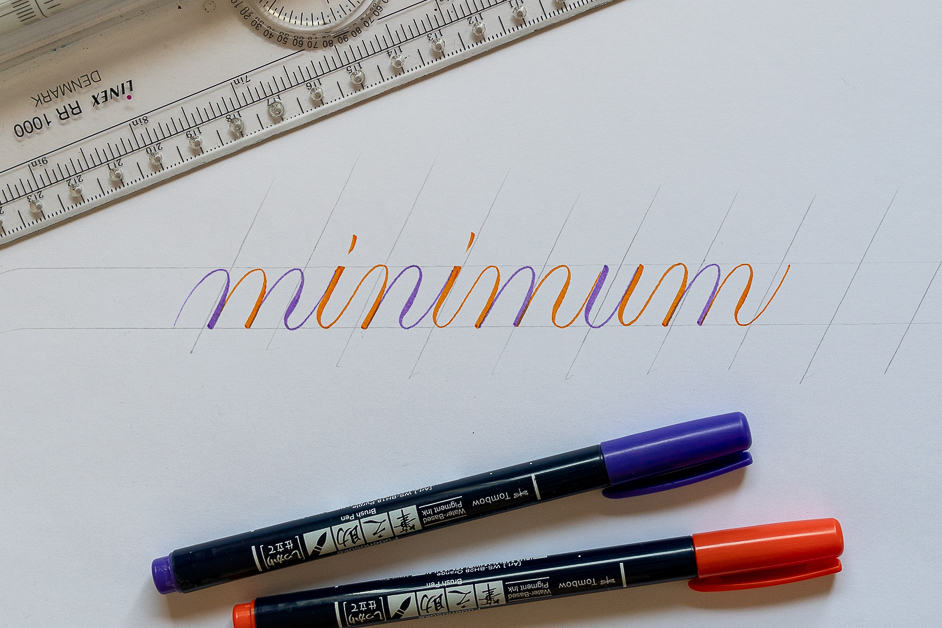
What is calligraphy used for?
Today, calligraphy is used in many different ways.
From personal use as a relaxing hobby and artistic expression to commercial purposes, official documents, wedding invitations, font designs, and much more.
The written word can be used to convey not only information but also emotions.
As you can see in the image below, the same sentence written in two different styles can communicate a very different feeling.
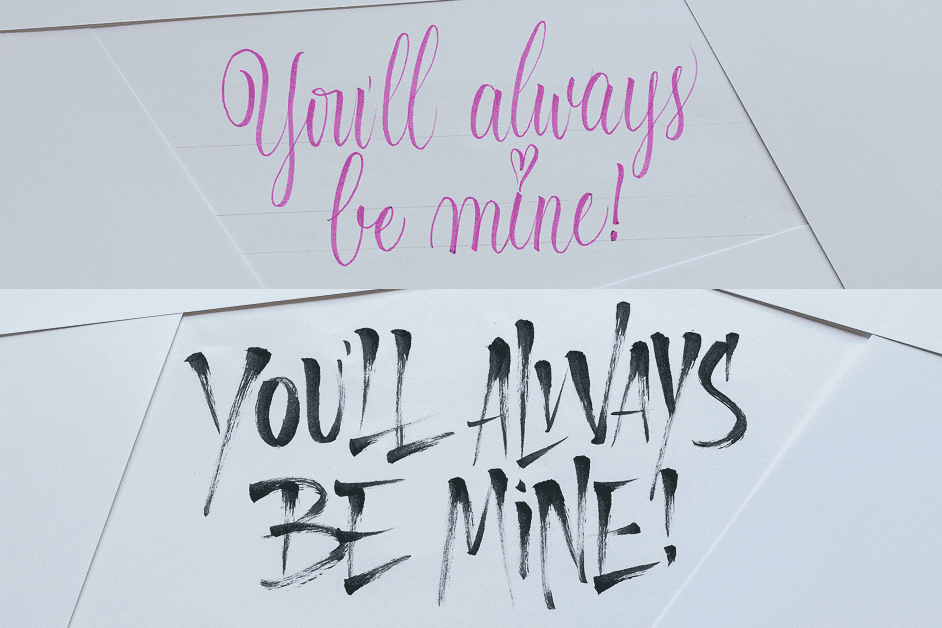
Often we don’t pay any attention to letters used in advertisements, logotypes, and other promotional materials.
Try to pay more attention the next time you’re in the city or any other place where you can see letters around you.
Take a moment to look at the letters and think about what they communicate on an emotional level and how they make you feel.
This could also be a helpful exercise to determine what sort of style of calligraphy you want to learn and practice.
At this point, it’s also important to mention that calligraphy and hand lettering are not the same thing.
Despite the fact that these two terms are often used interchangeably.
When doing calligraphy, you’re writing letters, whereas, with hand lettering, you draw them.
I wrote an article about the difference between hand lettering and calligraphy . Check it out!
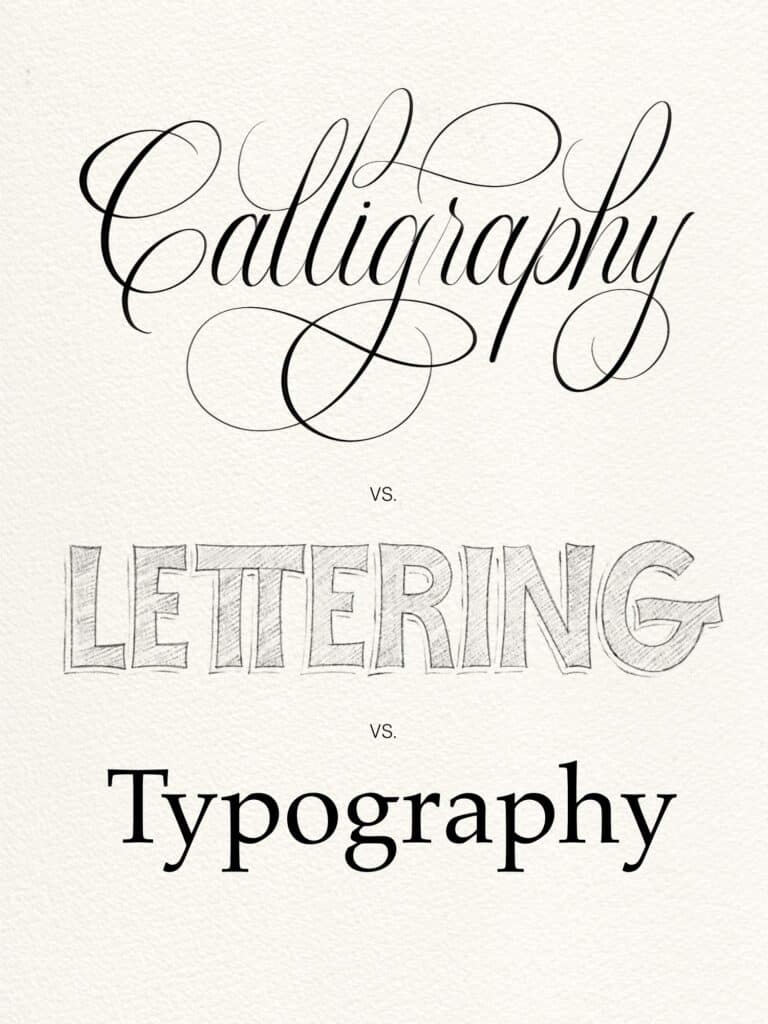
The Origins Of Calligraphy
Paleographers and historians believe the first alphabet evolved in Phoenicia around 1200 B.C.
As Phoenicians merchants traveled and traded across the Mediterranean, the Greeks adopted their alphabet around the eighth century B.C.
Soon after, the Etruscans adopted (and adapted) the Phoenician alphabet, which the Romans subsequently took.
By the first century B.C., the Romans had already developed several scripts using the Latin alphabet, which we all know and use today.
The word calligraphy derives from the Greek words “kallos” (beauty) and “graphein” (to write).
According to Britannica.com , the word calligraphy entered most European languages by the end of the 16th century.
This was initiated by the introduction of the printing press in the mid-15th century and thus created a clear distinction between handwriting and more elaborate forms of lettering.
We often take it for granted, but the written word is one of the foundations of human civilization.
Writing has allowed us to share and preserve information, ideas, and knowledge for thousands of years.
The history of calligraphy is rich, with many evolutions throughout centuries.
Below you can see a shorter general overview of how the Latin alphabet evolved throughout history.

In case you want to learn more about the history of calligraphy, I’ve written a separate in-depth article on the history of calligraphy and how it evolved throughout the years.
How to get started with calligraphy? The three-step formula
Ok, now we know what calligraphy is, what it is used for, and where it comes from.
Now it’s time to learn how to start learning and practicing calligraphy.
If you’re a complete beginner, the best way to start learning calligraphy is by following the three-step formula :
- Choose a calligraphy style that you want to study and practice.
- Pick the correct calligraphy pen for the style you want to practice + the essential calligraphy tools.
- Find a proper study resource and create an effective practice routine.
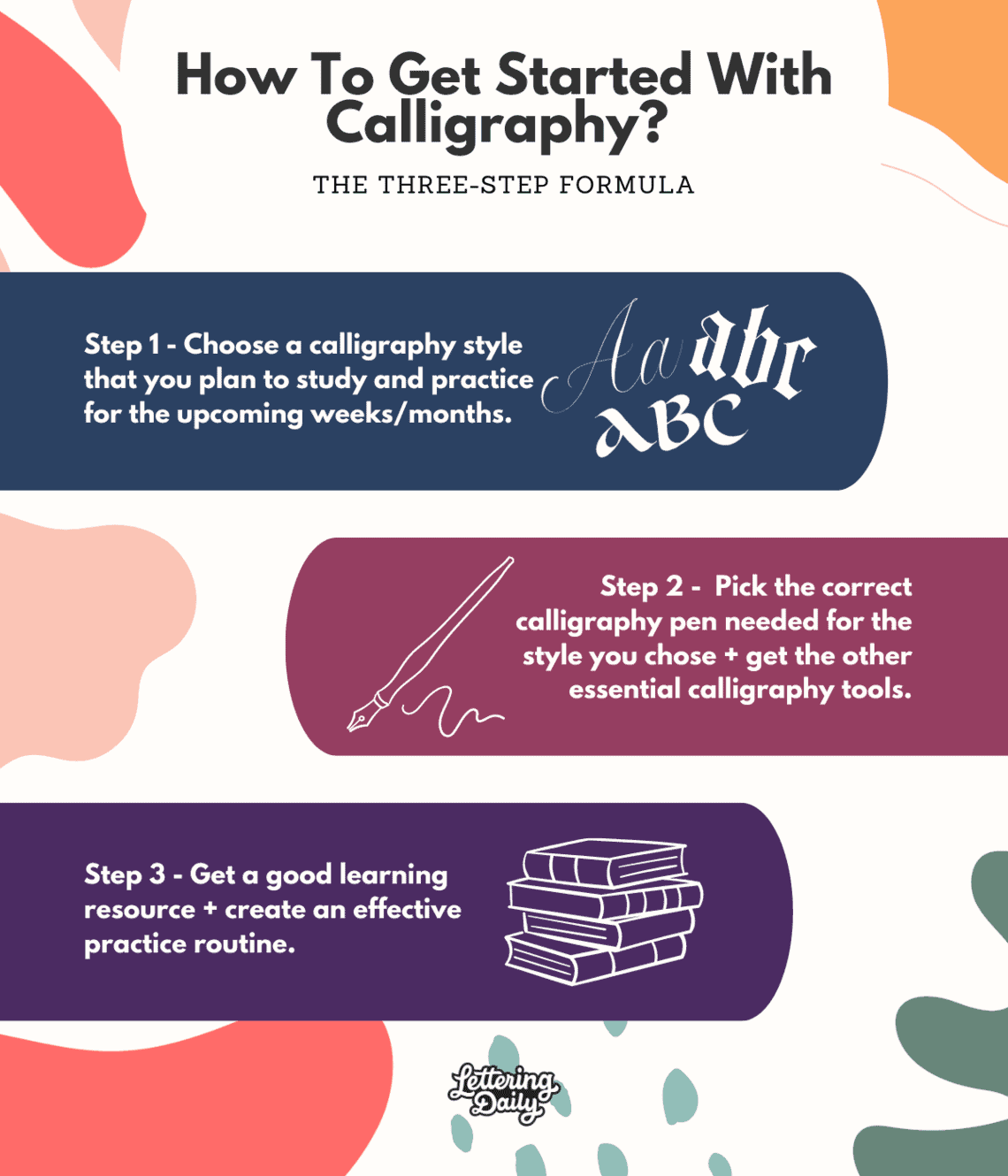
With that in mind, let’s have a closer look at each of these three key steps.
Step 1 – Choosing a calligraphy style
The first thing you should do is find the calligraphy style that appeals the most to you.
This is the first step since the next step (picking the tools) will depend on your calligraphy style, aka script choice.
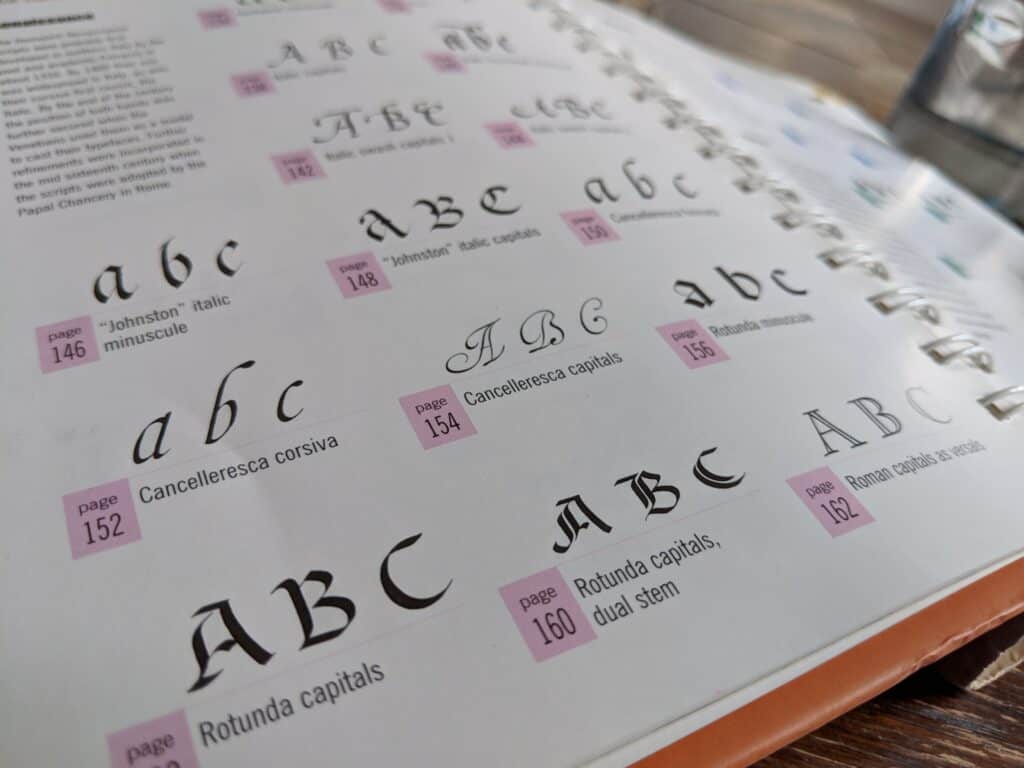
I often get asked what is the easiest calligraphy style to start with, and the truth is that each style has its little nuances that will create challenges along the way.
Some people might find working with a pointed nib easier, while others find it more comfortable with a broad-edged pen.
To learn, understand, and properly execute a specific calligraphy style, you need to stick to it for an extended period, so it’s essential that you choose something that is appealing to you.
Generally speaking, there are a few main categories of calligraphy styles.
We can categorize calligraphy styles according to the type of pen we use. The main categories are –
- Pointed nib calligraphy styles (Copperplate, Spencerian, etc.)
- Broad-edged calligraphy styles (Uncial, Gothic, Foundational, etc.)
- Brush pen calligraphy
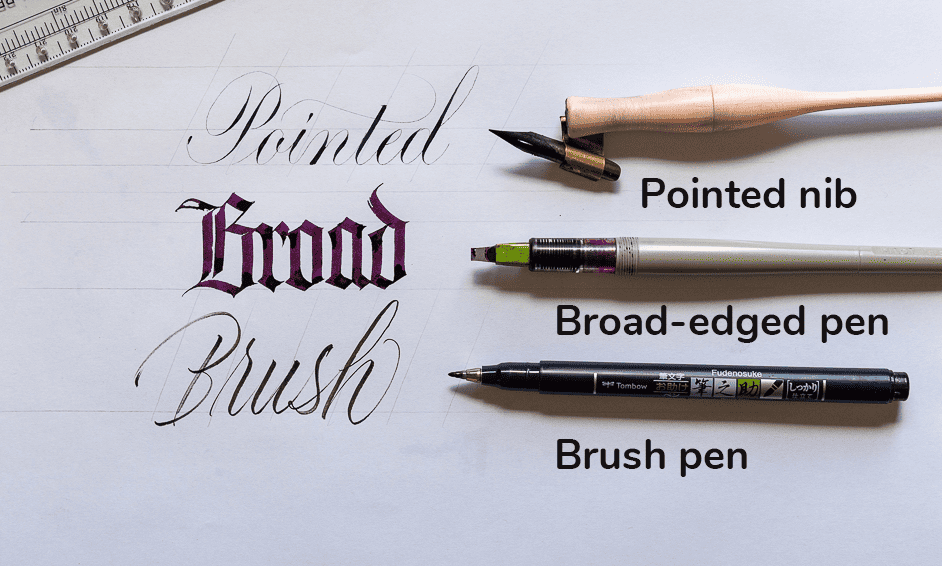
To make it easier for you, I created a separate guide on the 10 best calligraphy styles for beginners.
That article contains the most popular calligraphy styles and many helpful resources to help you make the right first step.
So if you’re a complete beginner, make sure to check out that article first.
Quick note: The different calligraphy styles are usually referred to as scripts. People commonly use the term “calligraphy fonts,” but that is incorrect. Fonts are what (today) computers use to display text.
Step 2 – Picking the correct calligraphy pen + the essential calligraphy tools
Remember, not every calligraphy pen suits every style.
This is why it’s crucial to pick the style and then the calligraphy pen that fits that style.
Entry-level pens and tools are not crazy expensive, but it would be silly to waste your money simply because you didn’t know what you needed to get started.

Luckily, with one pen, you can create a bunch of different styles.
On top of that, there are only three main pen categories to choose from.
To help you find the right pick, I have created a complete in-depth guide on choosing the right calligraphy pen.
In addition to the calligraphy pen, you will also need the basic calligraphy tools.
The basic calligraphy tools are :
- The calligraphy pen
- Calligraphy ink
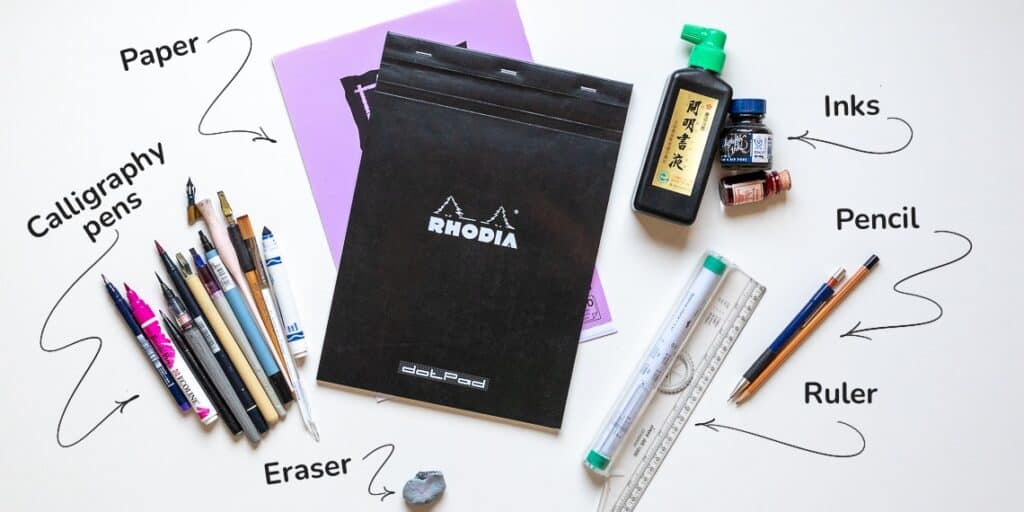
To learn more about this, I created a separate article on the 6 essential calligraphy tools.
By following these two guides, you will find the correct high-quality tools without wasting your time or breaking the bank.
What if you cannot afford or find any calligraphy tools in your area?
I wrote a tutorial where I show you how to create calligraphy with a regular pen , and if you have a pencil lying around, you can also do calligraphy using just a pencil.
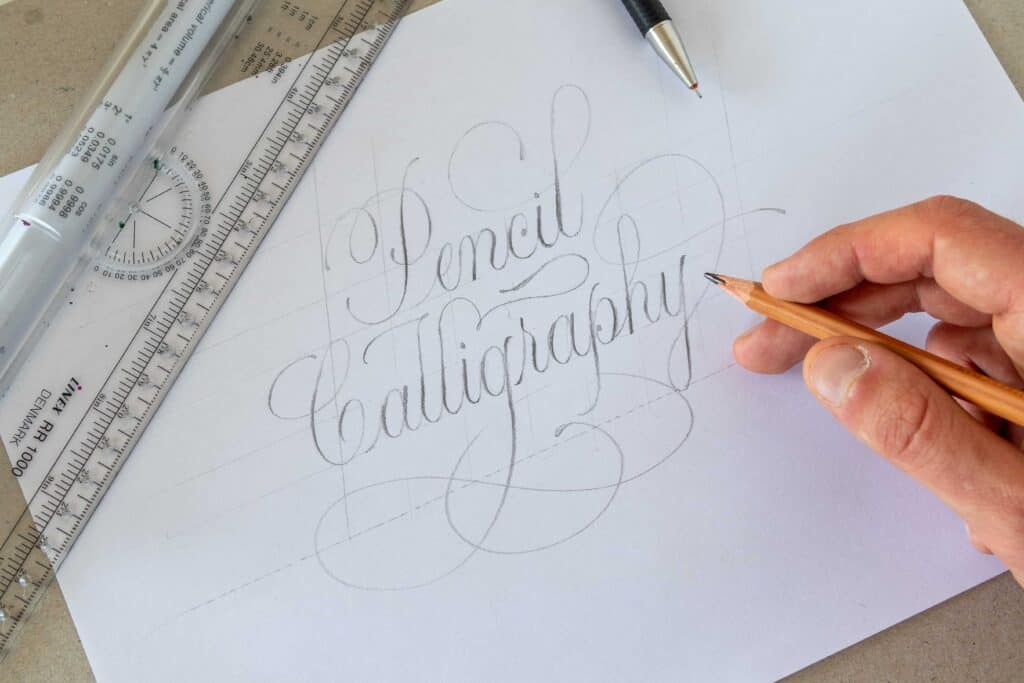
Other articles about calligraphy tools you might be interested in checking out :
- Calligraphy Paper – The Ultimate Guide For Beginners
- 10 BEST Brush Pens For Calligraphy Beginners
- 10 Useful Lettering And Calligraphy Tools
- How To Clean Your Calligraphy Nibs (5 EASY Ways)
- How To Make A Calligraphy Pen At Home
- Lettering & Calligraphy Gift Ideas (The ULTIMATE Guide)
Step 3 – Find a proper study resource and create an effective practice routine.
Once you’ve picked out the calligraphy style and the needed tools, it’s time to find a proper resource and start practicing.
One of the best ways to learn calligraphy is by attending an in-person workshop hosted by a professional calligrapher.
An online workshop is also great.
However, you can still find a bunch of great free resources online.
Instructional calligraphy books are also fantastic – I’ll talk more about them later on.
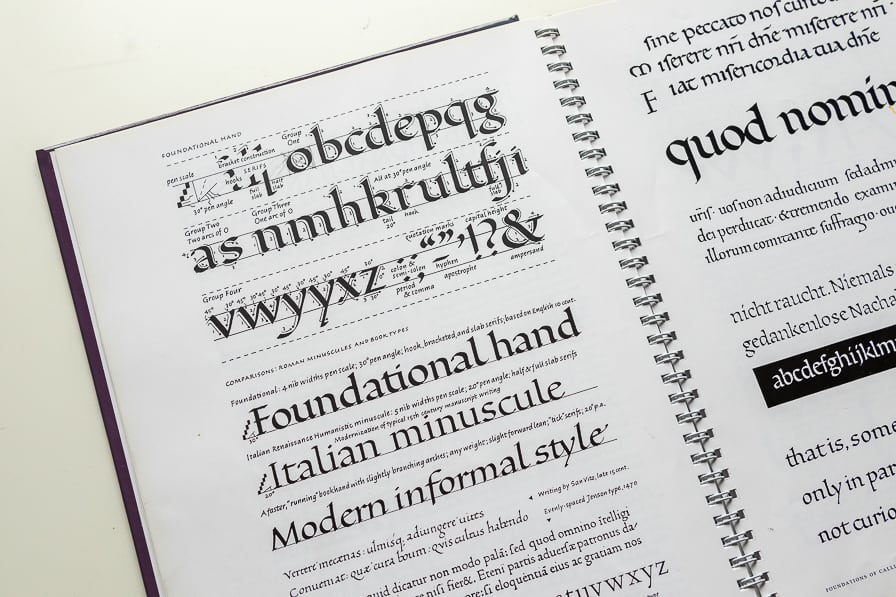
With the help of a good study resource, you’ll learn how to construct letterforms properly and keep your calligraphy proportional, consistent, and well-balanced.
Basically, all the elements you need to develop a strong foundation upon which you can then easily build more complex elements and learn new calligraphy styles.
You could just find an alphabet from Google Images or Pinterest and copy that for several months, but you might do more damage than good with that approach.
It’s much better to practice with a correctly structured exemplar that has a ductus along with it.
An exemplar is a full alphabet demonstration for you to use as a reference.
The ducts are the little red arrows indicating the stroke sequence to construct the letters. You can see an example of it below.
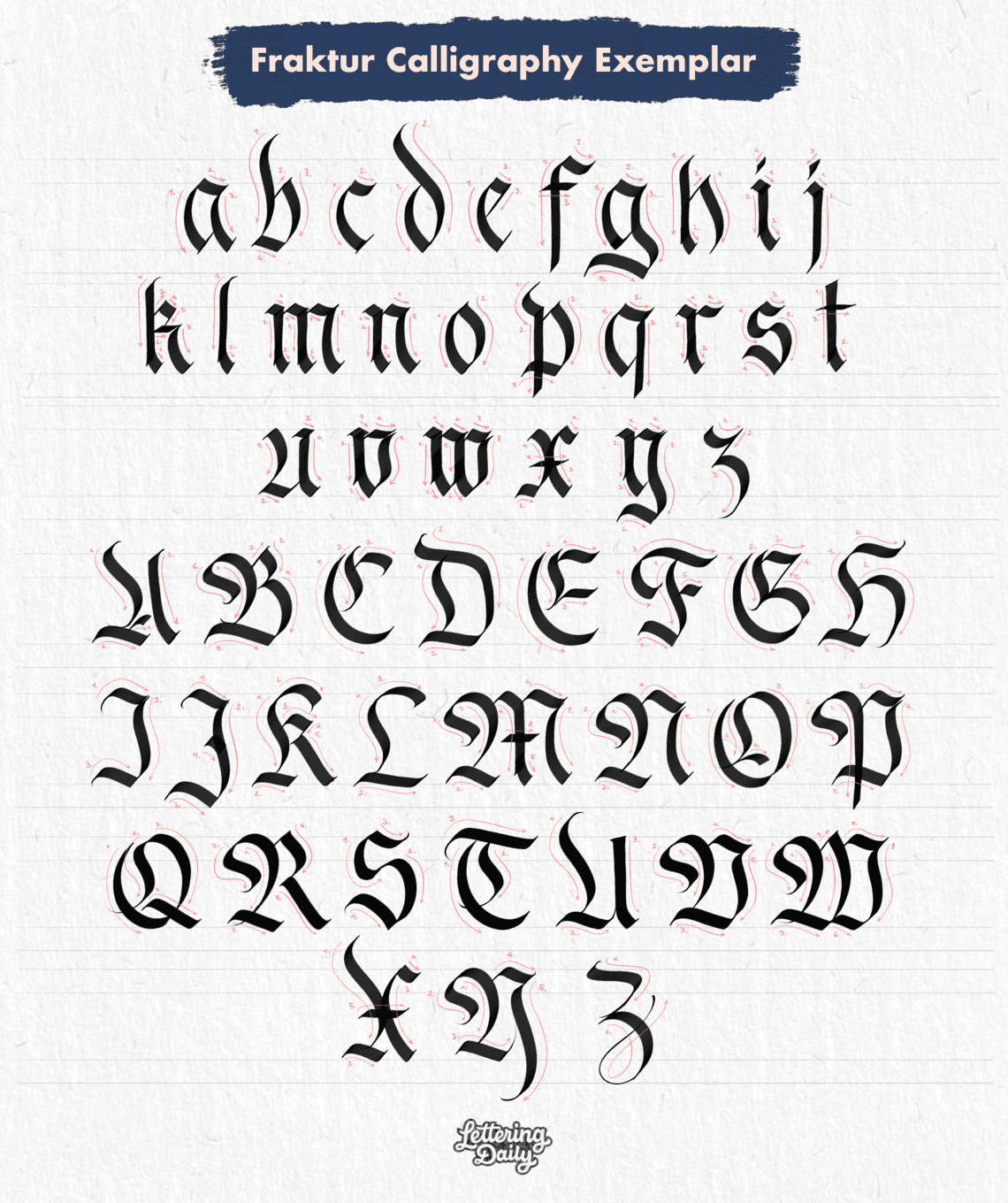
Trust me when I say this – finding a good study resource could make a massive difference in the quality of your calligraphy artwork and how quickly you can learn and improve your skills.
Here is a list of current step-by-step guides for various calligraphy styles that you can find on the Lettering Daily website –
- Blackletter/Gothic Calligraphy For Beginners (+FREE Worksheets)
- Fraktur Calligraphy Tutorial for Beginners (+FREE Worksheets)
- Italic Calligraphy For Beginners (+FREE Worksheets)
- Copperplate Calligraphy For Beginners (+FREE Worksheets)
- How To Get Started With The Foundational Hand (+FREE Worksheets)
- How To Do Modern Calligraphy (+FREE Worksheets)
- Brush Calligraphy Alphabet – a to z (Lowercase Letters)
- How to Do Faux Calligraphy (+FREE Worksheets)
- How To Do Pencil Calligraphy For Beginners (+FREE Worksheets)
- How To Get Started With Dip Pen Calligraphy (+FREE Worksheet)
- How To Do Calligraphy With Crayola Markers
- How To Draw Illuminated Letters
- How To Improve Your Handwriting (+FREE Worksheets)
This list will grow with time as I keep creating and adding more tutorials.
Creating an effective practice routine.
Calligraphy is a motor skill.
This means that the brain, muscles, and nervous system all need to work together.
It also means that building muscle memory requires a lot of practice.
In other words, the more you practice, the better you will become at calligraphy.
This is one of my favorite videos that describes in detail how practice helps us to improve any sort of skill :

However, it’s not just about the consistency of your practice that matters.
It’s also the quality of your practice that is crucial.
If you’ve been reading my articles or will be reading them, you will often see me repeat the following sentence: Consistent practice is important, but how you practice makes all the difference.
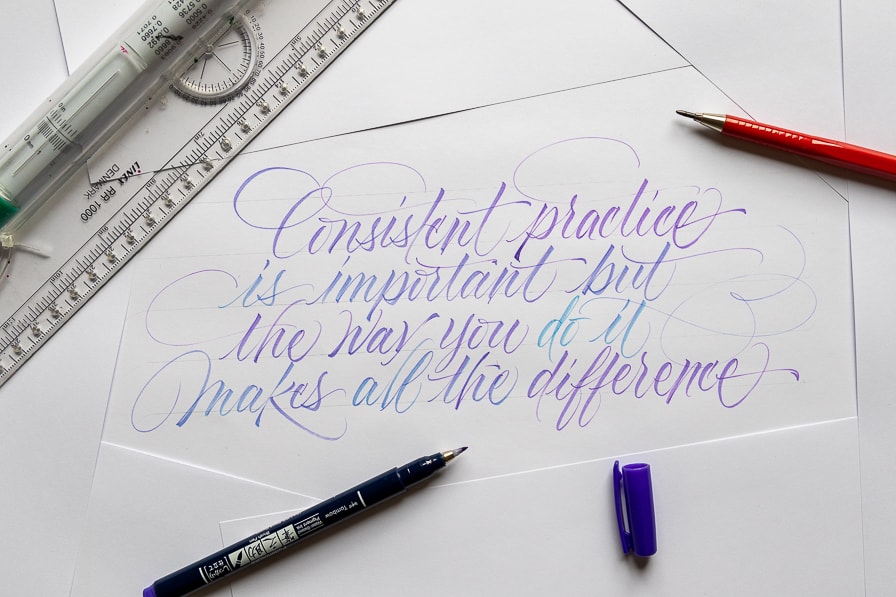
Over the years, I’ve seen some people progress more in six months than others in several years.
The key difference was almost always the way they practiced.
I cannot stress enough how important it is to create a good and effective calligraphy practice routine and how big of an impact it can have on your progress.
I also want to point out that it’s important that you make the routine fun.
Aimlessly copying basic strokes and alphabets can quickly become tedious.
I created a separate article on how to practice calligraphy effectively.
In that article, I share many helpful tips and a suggested practice approach that works for any calligraphy style you choose to practice.
On top of that, you can check out my article on the most common calligraphy mistakes and how to avoid them.
Additional learning resources for calligraphy
Alternatively, to the options mentioned earlier, calligraphy books can be a fantastic learning option.
Over the years, most of my calligraphy knowledge has come from calligraphy books.
I wrote an article sharing my top 10 calligraphy books for beginners.
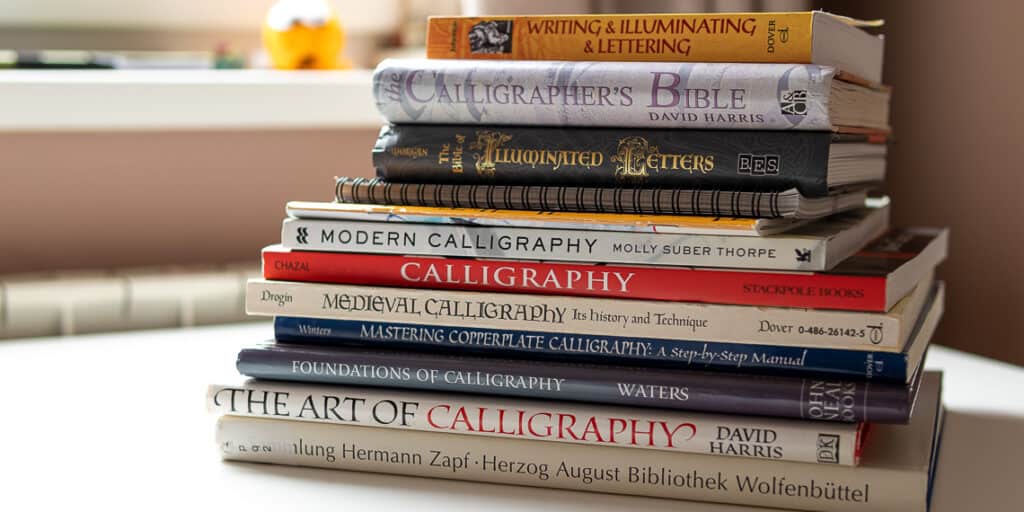
Other options are also online courses.
For example, Domestika and Skillshare offer some great online courses to help you start your calligraphy journey.
I also wrote an article sharing some of my favorite online calligraphy courses.
I prefer live or online workshops over courses (even if they are more expensive) because you can interact with the teacher, ask questions and get detailed feedback on your work.
Advanced calligraphy techniques and effects
Once have you covered the calligraphy basics, you can start experimenting with more complex effects and techniques.
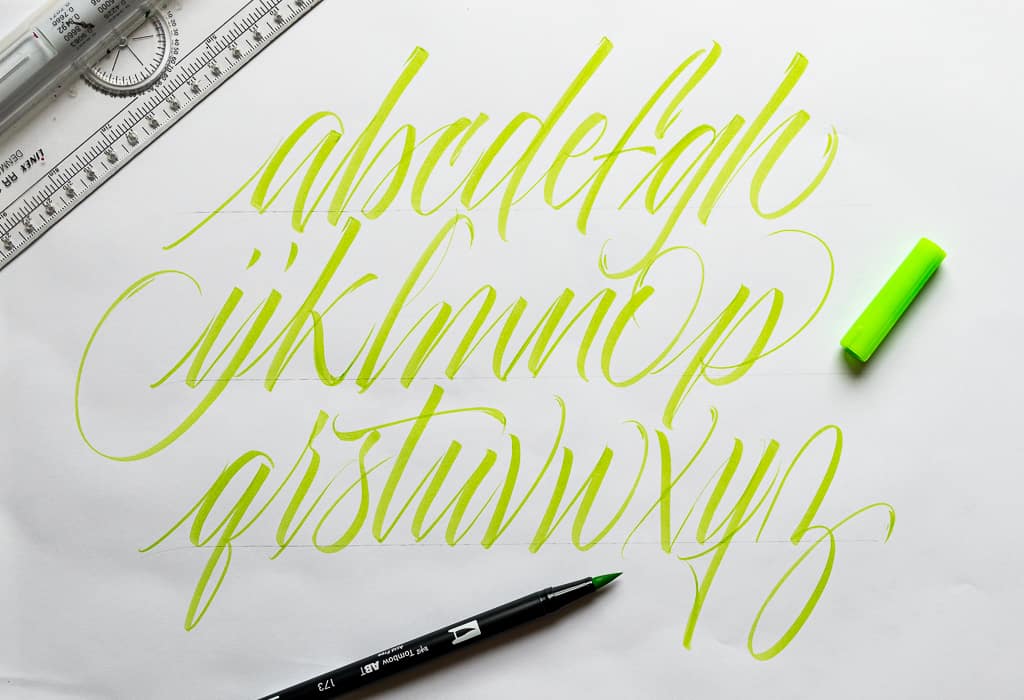
However, it is crucial that you go over the basics before you try different techniques and effects.
Below you can see a list of various tutorials and guides for calligraphy techniques and effects you can add to your work :
- How To Add Shadows To Your Letters (5 EASY Ways)
- How To Do Calligraphy Flourishing (+Free Worksheets)
- How To Dry Emboss Your Lettering By Hand
- Color Fundamentals, And How To Use Them In Your Lettering
- 5 Ways You Can Add a Gradient To Your Lettering
- How To Vectorize Your Hand Lettering (4 EASY Steps)
- How To Create A Calligram (Step-By-Step Tutorial)
- How To Create Brush Lettering Compositions With Ease
- How To Become Ambidextrous (Beginners Guide 2023)
- How To Do Water Brush Lettering (+FREE Worksheets)
Frequently asked questions about calligraphy
Here are some questions (and answers) that I get from calligraphy beginners :
Although both relate to writing with your hands, calligraphy focuses on artistic expression and creating visually pleasing letterforms. Regular handwriting, on the other hand, focuses on speed, efficiency, and conveying information.
No, calligraphy and cursive writing are two different things. Calligraphy uses specific tools, requiring deliberate and focused movement to create beautiful letters. Cursive writing, on the other hand, is a form of handwriting that you can execute much faster since it needs fewer pen lifts.
Yes, this type of calligraphy is also known as faux calligraphy, and I wrote a tutorial on how to do it.
You definitely can. You can monetize your calligraphy skills in numerous ways. Some common methods are client work, advertisement, wedding invitations, teaching (online and in person), selling products (physical and digital), and more.
Yes, if you have the desire and the patience, you can learn calligraphy at any age.
Yes. Many great online resources can guide you through all the needed steps to get started. The online community is also very active and supportive, so you can always ask questions and get feedback from more experienced calligraphers. Aside from free online resources, you can also get an instructional book about calligraphy and attend an online or in-person workshop.
You can learn calligraphy regardless of the quality of your handwriting. The two are different from each other. All you need to learn calligraphy is a good attitude and patience to learn the skill since it does take a while. In case you want to improve your handwriting, check out this article.
It can get expensive, but you dont need to spend a lot of money to get started. You only need to spend 20-30 $ (USD) to get you started. In my calligraphy tool guides, I’ve shared many tools that are of great quality and don’t cost that much.
There is no exact answer to this question. It does take several months to get a good grasp of the basics. It all depends on the quality and frequency of your practice. I’ve shared some helpful tips in my article on how to practice calligraphy effectively.
My motto is – consistency over intensity. In other words, you can get better results from practicing 15-20 minutes daily than doing two hours twice a week.
I can only speak from personal experience. For me, calligraphy is a therapeutic activity that benefits my mental health. According to this article , there is concrete evidence of the benefits of calligraphy for mental health.
Before you’re able to develop your calligraphy style, you have to learn the basics first. By understanding the basics of calligraphy, you will develop a strong foundation that will allow you to develop your style. In other words, you must learn the rules before you break them.

Recap + Final words
Here is a quick recap of the beginner guide to calligraphy :
- Calligraphy is the art of beautiful writing.
- The word calligraphy derives from the Greek words “kallos” (beauty) and “graphein” (to write).
- Calligraphy and hand lettering are different from each other – read more about their differences here.
- Calligraphy is used to convey emotions as well as information.
- The three-step formula to start learning calligraphy is as follows –
- Choose a calligraphy style you like
- Find the right calligraphy pen + the essential tools.
- Find a good study resource + an effective practice routine.
- Explore additional learning resources.
- Once you’ve developed a solid foundation by practicing the basics, you can explore additional styles, techniques, and more advanced elements of calligraphy.
Calligraphy is a complex art form with many little nuances, and it takes years of studying and practice to master this skill.
However, getting started shouldn’t be too complicated, and I’m confident that if you follow this guide, you will start seeing concrete results fairly quickly.
I would like to hear it from you now :
What is the reason you decided to start learning calligraphy?
Also, what sort of style would you be interested in learning?
Be sure to drop a comment below. 👇
Until the next one!
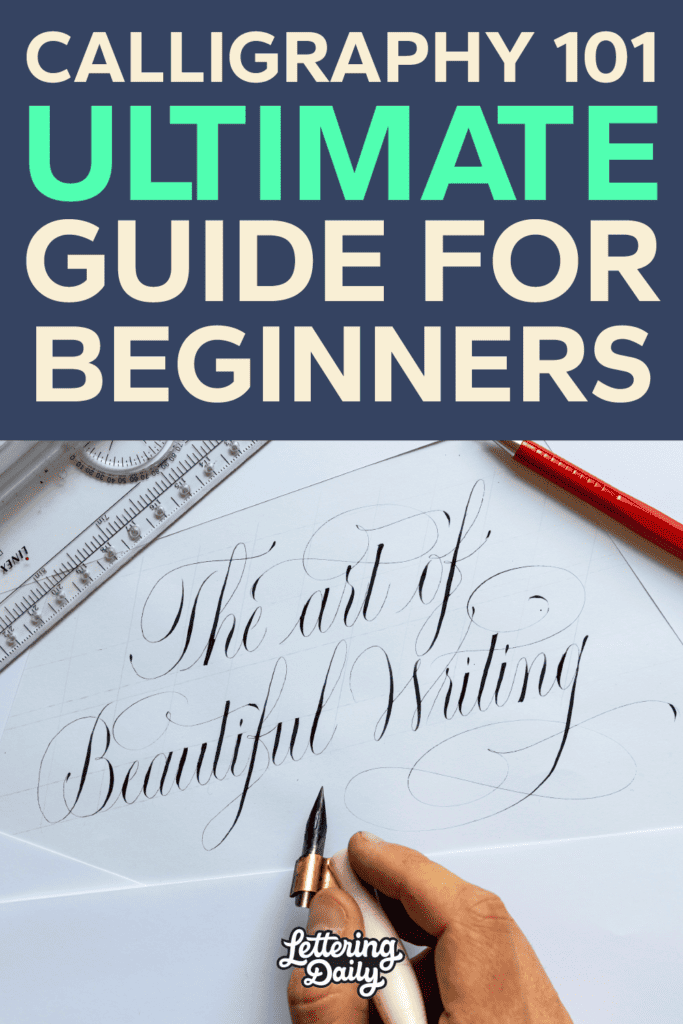
Stay updated with my tutorials and get instant access to the Lettering Crate –
A growing library of free lettering & calligraphy resources that includes –.
- Calligraphy practice sheets
- Procreate brushes
- The 30-day lettering planner
- Printables, and more!
About the author

Meet Max Juric, a dedicated calligraphy and hand lettering artist with over a decade of experience. His artistic journey is deeply rooted in a passion for lettering and a commitment to continuous growth. Max’s extensive experience spans several years as a full-time lettering artist, collaborating with clients from around the globe. Over the past five years, Max has actively shared his expertise, reaching more than 100,000 individuals monthly through a rich array of educational resources. These resources include tutorials, interviews, articles, and podcasts. Max’s practical experience, combined with his unwavering dedication to his craft, sets him apart in the realm of hand lettering and calligraphy. With an educational platform offering over 100 long-form resources, Max aims to guide artists and enthusiasts in enhancing their hand lettering and calligraphy skills. Welcome to Lettering Daily, where artistic expression and learning beautifully intersect.
18 thoughts on “Calligraphy 101 – The ULTIMATE Guide For Beginners”
Thank you for all the content you have created and I look forward to what’s next. I love writing poems and I always thought poems look so boring on paper because I am not very good at drawing. So at a very young age I started to obsess over pretty writing, that’s how I came to my obsession with dip pen calligraphy. I love copperplate and spencerian

Hey Jillian, thank you so much for the kind comment 🙂 Would love to see some of your Copperplate and/or Spencerian.
Thanks Max for your newsletters and for this Calligraphy 101 Guide, plus all the extra topics and articles. Something you could put in your newsletter is where you get your calligraphic supplies and books from–Amazon, local art store, etc. Typism 2023 starts next week. I wonder if anyone is going to teach a class geared toward calligraphic art, mementos and such, for the 2024 Paris Olympics? (hopefully, the civil unrest will get settled). I took Natalie Brown’s Greeting Card 101 class, Typism 2022. Nice class, but am having difficulty with understanding PS/AI Pen Tool technique in order to vectorize my art, so it can be sent to a publisher. I’m getting help though. Bruce, North Carolina, US.
Hey Bruce, thank you so much for the suggestion. I have all those links on my site, but I will include them in my next newsletter as well. Shoot me an email, and i’ll send you some great resources that will help you with manual vectorization of your calligraphy. It’s not the easiest skill to learn but also not the hardest one. It just takes practice.
Thank You very much for this article, is a lot of very interesting information. Regards, Jose
Thank you for the nice comment, Jose. I really appreciate it! 🙂
Hello Max, This is an excellent resource for, in my opinion, calligraphers and lettering artists at all levels, from beginner onwards. Thanks for for the all the work you put into it — I know that I’ll come back to it often. Drew
Thank you so much, Drew. I am happy to hear you think that about my article, it really means a lot! 🙂
Hi there, Your emails and articles are very interesting and informative. I appreciate all the work you put into them. You must be a workaholic. 🙂 Nonetheless, I decided to get into calligraphy because it is a beautiful art form of conveying messages and I would like to give scripture messages using calligraphy as gifts to friends and family. I haven’t decided what style I will be using yet. However, I do like the templates you provided for your faux calligraphy fonts and I have been using that since I signed up with you. I have been painting them in gold. Thanks again for your sharing and generous spirit. God willing it will pay off.
Hey Lorraine, thank you so much for the awesome comment 😀 I used to consider myself as a workaholic before but now i think i have more work/life balance. I just enjoy doing this so i dont necesarily consider it as conventional work 😀 Faux calligraphy sounds awesome! Let me know if you ever struggle with something, always happy to help.
Max, you are a wonderful human being! Again, you have provided fabulous information (free!) for beginning calligraphers and those who want to improve their calligraphic skills. I’m always impressed with the offerings you provide and love to recommend your site to people…they will get quality guidance to steer them in the right direction! Thank you for all you do to promote calligraphy!
Thank you so much, Gail! You are awesome! It really means a lot hearing these things – thank you! 🙂 <3
Excellent resource for beginners or those wishing to advance their skills or expand their style range.
Thank you so much, Eden. I really, really, really appreciate it! 🙂
Damn, son, what a resource! I love the infographic and the other illustrations. Keep this gold coming. 🔥🔥🔥
Muchas gracias chica 🙂 I really appreciate it 🙂
What a wonderful Masterclass. The most in depth Calligraphy guide I’ve ever seen. Hats off Max!
WOWOWOW! Thanks so much bro! 🙂 Means a lot to hear that from you.
Leave a Comment Cancel Reply
Your email address will not be published. Required fields are marked *
Save my name, email, and website in this browser for the next time I comment.
This site uses Akismet to reduce spam. Learn how your comment data is processed .
If you download or print anything from this site, please consider making at least a $ 10 .00 donation through PayPal. I can maintain and expand this website only with your help.
Back to Assignments or Home . Updated 13 March 2024 .
choose a handwriting
I'll upload my own
I'll use a default template
upload your handwriting
- Download and print-out this template
- Fill in each box with your handwritten characters in the same order as shown
- Upload the filled template and await, as the magic happens :)

select a default template
visit us on desktop to use your own handwriting
Click again if not redirected
behind the magic

Aditya Agarwal
Developer by day, and also by night. Creating tech to power the future.
Who is Aditya?

An artist who wants to make it possible to paint worlds beyond earth.
Who is Samarth?

Always remember, it's the step upgrades to objects and processes. Happy 'hand-writing'!!
Who is Manas?
contact us at [email protected]
© 2022 handwriter.in
Online Class: Western Calligraphy

- 43 Exams & Assignments
- 3,851 Students have taken this course
- 15 Hours average time
Course Description
"The Timeless Elegance of Western Calligraphy: Crafting Words into Art"
From the ancient scrolls to the elegant wedding invitations of today, the art of Western calligraphy has been an embodiment of beauty, elegance, and profound emotions. More than just a skill, it's a dance of the hand, a meditation, and a way to breathe life into letters. As each stroke unfolds, it tells a story; of traditions, of history, and of personal journeys. Are you ready to embark on this enchanting voyage of crafting words into art?
Delve Deep into the Heart of Western Calligraphy:
In this course, we shall traverse through the intricate alleys of Western calligraphy, which is not merely a hobby but a soulful pursuit. In an era where digital text dominates, calligraphy offers an intimate, tactile experience of words, bringing back the nostalgia of handwritten notes and personal touches.
Unravel the Magic, One Letter at a Time:
From the foundational hand to the Gothic script, from Italic to Copperplate, this course will introduce you to the vast spectrum of Western calligraphy. Each script has its own history, its rhythm, and its spirit. We'll meticulously dissect each letterform, allowing you to understand the flow and finesse behind it.
For Everyone and Anyone:
Artistic background or not, age no bar; calligraphy is universal. Whether you are an artist yearning to add another skill to your portfolio, a retiree seeking a meditative hobby, or a student wanting to create hand-lettered projects, this course has treasures for everyone. Young, old, or somewhere in between, the magic of calligraphy awaits.
Expand Your Canvas:
While paper is the traditional choice, calligraphy is limitless. Imagine crafting elegant script on ceramic plates, delicate glassware, rustic wooden boards, or soft fabric. The potential applications are endless, and by the end of this course, you'll be equipped to turn any surface into a piece of art.
Build and Flourish:
With the skills acquired, you could explore numerous avenues. Personalize gifts, offer custom-made calligraphic services, or launch your own line of hand-lettered products. Whether it's selling at local fairs, collaborating with stationery brands, or starting an online store, the world is your oyster.
Journey with an Expert:
Guided by Nancy, a seasoned calligrapher, you'll be mentored with care, patience, and passion. Her insights, drawn from years of experience, will ensure that every question you have is answered, every challenge you face is surmounted.
Community and Beyond:
As you delve deeper, you'll become a part of a thriving community of calligraphers. Share your work, seek feedback, collaborate on projects, and immerse yourself in the sea of inspiration that surrounds this art form.
- Historical Perspectives: Dive into the fascinating history of calligraphy, understanding its evolution and significance through eras.
- Materials Mastery: Navigate the vast array of calligraphy tools, from quills and nibs to a myriad of inks and papers.
Words as Legacy:
In a world fleeting by, calligraphy offers a moment of stillness, a connection to our roots. The letters you craft today could be treasures for generations tomorrow, heirlooms that carry the weight of your emotions and the beauty of your artistry.
So, why wait? Embark on this transformative journey, where words transcend their meanings, where every letter you pen is a reflection of your soul, and where art and language converge to create magic. Dive deep, let the rhythm of calligraphy engulf you, and discover the artist within. Sign up today and let your journey into the world of Western Calligraphy unfold! 🖋📜🎨

- Completely Online
- Printable Lessons
- 6 Months to Complete
- 24/7 Availability
- Start Anytime
- PC & Mac Compatible
- Android & iOS Friendly
- Accredited CEUs

Course Lessons

Lesson 1: History of Calligraphy
Lesson 2: Materials and Supplies
Lesson 3: getting started, lesson 4: uncial calligraphy, lesson 5: foundational hand calligraphy, lesson 6: roman rustic calligraphy, lesson 7: versals calligraphy, lesson 8: batarde calligraphy, lesson 9: italic calligraphy, lesson 10: copperplate calligraphy, lesson 11: gothic calligraphy, lesson 12: more and more calligraphy, lesson 13: beyond the alphabet and chinese calligraphy, lesson 14: flourishes and decoratives, lesson 15: final fonts and calligraphy from around the world, lesson 16: onward and upward, learning outcomes.
- Describe the history of calligraphy.
- Determine materials and supplies needed.
- Describe and demonstrate uncial calligraphy.
- Describe and demonstrate foundational hand calligraphy.
- Describe and demonstrate Roman Rustic Calligraphy.
- Describe and demonstrate Versals Calligraphy.
- Describe and demonstrate Batarde Calligraphy.
- Describe and demonstrate Italic Calligraphy.
- Describe and demonstrate Copperplate Calligraphy.
- Describe and demonstrate Gothic Calligraphy.
- Demonstrate mastery of lesson content at levels of 70% or higher.
Additional Course Information

- Document Your Lifelong Learning Achievements
- Earn an Official Certificate Documenting Course Hours and CEUs
- Verify Your Certificate with a Unique Serial Number Online
- View and Share Your Certificate Online or Download/Print as PDF
- Display Your Certificate on Your Resume and Promote Your Achievements Using Social Media

Choose Your Subscription Plan
Student testimonials.
- "It was a great class. I did learn a lot. Everything I write now is calligraphy. Thank you for the great course." -- Sonia M.
- "I really didn't have an expectation of the material, I only had previously associated calligraphy with beautiful writing. But the course opened my eyes to the history and it was very interesting and presented very clearly." -- Meiissa P.
- "Its been amazing. The exams are quite intense but have enjoyed the practical elements most." -- Billie-rose D.
- "It was fun! The homework was hard." -- Dh H.
- "Enjoyed the class and feel I learned a lot!" -- Theresa S.
Related Courses

- Course Catalog
- Group Discounts
- Gift Certificates
- For Libraries
- CEU Verification
- Medical Terminology
- Accounting Course
- Writing Basics
- QuickBooks Training
- Proofreading Class
- Sensitivity Training
- Excel Certificate
- Teach Online
- Terms of Service
- Privacy Policy

Stock up! USA orders $85+ from the Supplies Shop ship free ! →

Your cart is currently empty!
26 “Real Life” Calligraphy Practice Projects
Lindsey Bugbee
— 20 Comments
When it comes to calligraphy practice, people often run into a rut. Today, I’ll share 25 unique tutorials with you that have a strong dip pen focus! All of these tutorials have “real life” applications as gifts or home décor.
- Click to share on Pinterest (Opens in new window)
- Click to share on Facebook (Opens in new window)
- Click to share on Twitter (Opens in new window)
- Click to email a link to a friend (Opens in new window)

Every time you pick up your dip pen and write, you’re getting in some calligraphy practice. For your first few calligraphy sessions, that practice should be structured — ideally with a worksheet or a video course so you can learn the basics. But once you understand how to hold your pen and (mostly) regulate ink flow, it’s time to take on projects! Today, I’ve got several suggestions for real life projects that you can use your calligraphy skills to make.
1. This Calligraphy Birthday Card
This card is an all-time favorite tutorial on Instagram. People make it all the time, yet no two cards look alike!

2. This Calligraphy Medallion
Medallions help you to practice calligraphy because they’re basically one big, gorgeous calligraphy drill.

3. This Shortcut Calligraphy Passage Concept
If you’ve got a light box and 45 minutes or so, you can write out practically any passage.

4. This Silhouette Artwork
Choose a favorite poem, play, or book, and use its words to make this lovely artwork. Mine hangs in an 11″x14″ frame with a mat in our guest bathroom.

5. This Flourished Tree Holiday Card
Take advantage of free time this summer to make this tasteful flourished card. You’ll be all set for the holiday season! (There’s also a heart version for Valentine’s Day.)

6. This Perfect Envelope
… Because you won’t find better calligraphy practice than writing out (and centering!) an address.

7. These Place Cards
If you’re too intimidated to make these cards for a formal celebration, try using a family dinner as an excuse for doing a “dry run”.

8. This Goal List
In my experience, goals are easiest to achieve when you see them every day. And goals are easiest to display when they’re beautifully written out!

9. This Comforting Card
I made this card for a friend who was feeling a little down about the COVID quarantine. However, you could modify the concept to fit any occasion.

10. This Calligraphy Ampersand Art
This ampersand gives you a great opportunity for calligraphy practice, and it makes a stellar gift!

11. This Flourished Bunny Envelope Art
My nieces (ages 6 and 4) were so happy to receive this envelope. Who doesn’t love a cute bunny?!

12. This Balloon-Themed Birthday Card
This card does require just a bit of illustration, but I promise it’s simple! Use the balloon strings to convey your warm wishes with calligraphy.

13. These Gift Tags
A midcentury design motif meets Amy Style calligraphy to result in holiday gift tag perfection!

14. This Flourished Phrase
With just a few sweeping strokes, you can transform an ordinary phrase into an eye-catching work of art.

15. This Personalized Feather Banner
I love to make these bohemian banners for guests.

16. This Traceable Calligraphy Flourishes Card
Don’t be intimidated: these flourishes are all traceable from a free template (you can find it in the tutorial ).

17. These Paper Sashes
Nothing ties your paper goods together better than paper sashes, both visually and literally! Make calligraphy on your sashes, and you’ve got a beautiful presentation.

18. This Christmas Tree Calligraphy Envelope
This envelope is so magical that I made it for my friend in 2017, and I never could bring myself to let it go! Now that she’s moved, I have an excuse to keep it forever.

19. This Calligraphy Exemplar
If you’re up for developing your own calligraphy style, try making an exemplar so you can remember all of the letter formations!

20. This Breezy Envelope Art
The fun, coastal look of this envelope art is the perfect complement to a summer day!

21. This Flourished Swan Envelope Art
Feeling up for a calligraphy practice challenge? Try tackling Schin Loong ‘s swan envelope art!

22. This Flourished Calligraphy Country or State Artwork
You can use calligraphy and flourishes to fill in any country or state silhouette, which makes for a fabulous gift!

I also used this concept to make this artwork , which I gave to my (Kansas-dwelling) brother as a Christmas gift:

23. This Fabulous Family Tree
I made this family tree for my mom’s birthday. She’s absolutely in love! A simple calligraphy family tree like this one can help to make any space feel a little more homey.

24. This “Little Black Dress” of Calligraphy Birthday Cards
I call this the “little black dress” of calligraphy birthday cards because it’s perfect for everyone! Man, woman, close friend, vague acquaintance … you can confidently give this card to anyone.

25. This Quick Calligraphy City Map
This simple project incorporates a hand-drawn roadmap, calligraphy, and lettering. If you’re looking for a quick and meaningful gift, give this map a try!

26. These Watercolor and Calligraphy Buffet Food Place Cards
These charming tented cards provide guests with essential information about the food they’re about to enjoy and add an elegant touch to your table or buffet setup!

Remember that calligraphy practice should always be fun, so work on whatever you feel like. There will be some days where you’d prefer to practice with a worksheet or do some drills, and there will be other days where you want to freestyle a bit! I hope that this article gets you excited about project ideas and helps to show you that dip pen calligraphy can be versatile in its applications. Enjoy!

inspiration in your inbox
Let The Postman’s Knock Spark Your Creativity
TPK’s innovative newsletters and tutorials are a regular artistic treat. Join the 125K+ subscribers who have already discovered The Postman’s Knock, and receive 10% off your first Digital Catalog order.
- Bold Text Generator
- Crossed Out Text Generator
- Italic Text Generator
- Small Text Generator
- Superscript Text Generator
- Tiny Text Generator
- Wide Text Generator
- Aesthetic Text Generator
- Backward Text Generator
- Bubble Font
Calligraphy Text Generator
- Cool font generator
- Cursive Text Generator
- Cute Font Generator
- Extra Thicc Text Generator
- Glitter Text Generator
- Special Letters
- Special Text Generator
- Spongebob Text Generator
- Stylish Text Generator
- Vaporwave Text Generator
- Instagram Font Generator
- Facebook Font Generator
- Twitter Font Generator
- Tumblr Font Generator
- Fortnite Font Generator
- Discord Font Generator
- CSGO Font generator – CS:GO
- Gaming font generator
- Creepy Text Generator
- Cursed Text Generator
- Demonic Text Generator
- Glitch Text Generator
- Gothic Font Generator
- Mirror Text Generator
- Scary Text Generator
- Weird Text Generator
- Zalgo Text Generator
- Braille Translator
- English to Binary
- Old English Translator
- Runic Translator
- Sign Language Translator
- Wingdings Translator
- Morse code translator
- Privacy Policy

Convert Normal Fonts into a Calligraphy Text
𝒞𝑜𝓃𝓋𝑒𝓇𝓉 𝒩𝑜𝓇𝓂𝒶𝓁 𝐹𝑜𝓃𝓉𝓈 𝒾𝓃𝓉𝑜 𝒶 𝒞𝒶𝓁𝓁𝒾𝑔𝓇𝒶𝓅𝒽𝓎 𝒯𝑒𝓍𝓉.
Your text will appear here..
Here’s how the font Generator Works: The fancy and pretty calligraphy word and font name generator is a fun and extremely user-friendly tool. All that you have to do is type in a text and different versions of it will appear right underneath or next to it. This is very convenient and beneficial for those who wish to write using a calligraphy font considering that through this text generator you can simply copy and paste the newly converted calligraphy text wherever you want as long as the website or social media platform supports Unicode. Now, the question that comes to mind is what exactly is Unicode and how does it make the calligraphy text generator different from copying and pasting a calligraphy generator from anywhere on the internet or otherwise. Whenever you see a font online, sometimes you wish to use that font elsewhere as well. You happily copy that font and try pasting it on a Superscript social media platform, etc but to your dismay, the font never gets there correctly. This happens because the place that you copied that font from is not based on Unicode.
What can Calligraphy Font Generator do for you:
You can create beautiful and fancy font styles with this calligraphy text generator for your social media or any other purpose. 𝓙𝓾𝓼𝓽 𝐂𝐨𝐩𝐲 & 𝓟𝓪𝓼𝓽𝓮!
Nowadays, there is a large number of fonts and text styles out there that one can choose from while writing traditionally or typing digitally.
There are some fonts, however, which stand out because they have a deep history. Fonts like these are timeless and their value only increases with time. An example would be the calligraphy style.
Calligraphy Text Generator Copy & Paste
If one looks at the history of this font, one finds out that it was perhaps the Romans who made this font widely available to the masses. The word calligraphy is essentially a Greek word that translates into beautiful writing.
Recommended: Zalgo Font Generator
The calligraphy font style is a writing style that has been used in holy scriptures, letters, texts, literature, and much more.
This font is indeed a class apart and its beauty is remarkable. The Cursive text style is also used widely in the Arabic language and is a major part of Islamic art as well. It is an extremely intricate style of writing that needs years of practice before one can master it and there is still always more room to learn and improve by seeking knowledge about different styles of fancy calligraphy.
And not everyone can easily write using this font. This is why the calligraphy generator is the perfect tool for all those who wish to write or type using this font without having to make an excessive effort and learn via years of practice. The calligraphy text generator lessens your work substantially and you can still achieve the same result thanks to this amazing calligraphy fonts generator.
From penning down letters to writing invitations or artistic texts, the calligraphy text generator has it all covered for you giving your text a unique and vintage yet formal vibe like no other.
How does it work?
It is Unicode that makes copying and pasting so convenient and easy making the calligraphy font appear just as it is on several social media platforms and places.
Another different thing about Unicode is that while it may appear that this text generator simply changes the text into a different font or a variety of different fonts, this is not what is happening. Instead, Unicode script symbols are generated which look very much like the Latin alphabet itself. Unicode has tens of thousands of symbols which allows us to have access to several different font styles, etc.
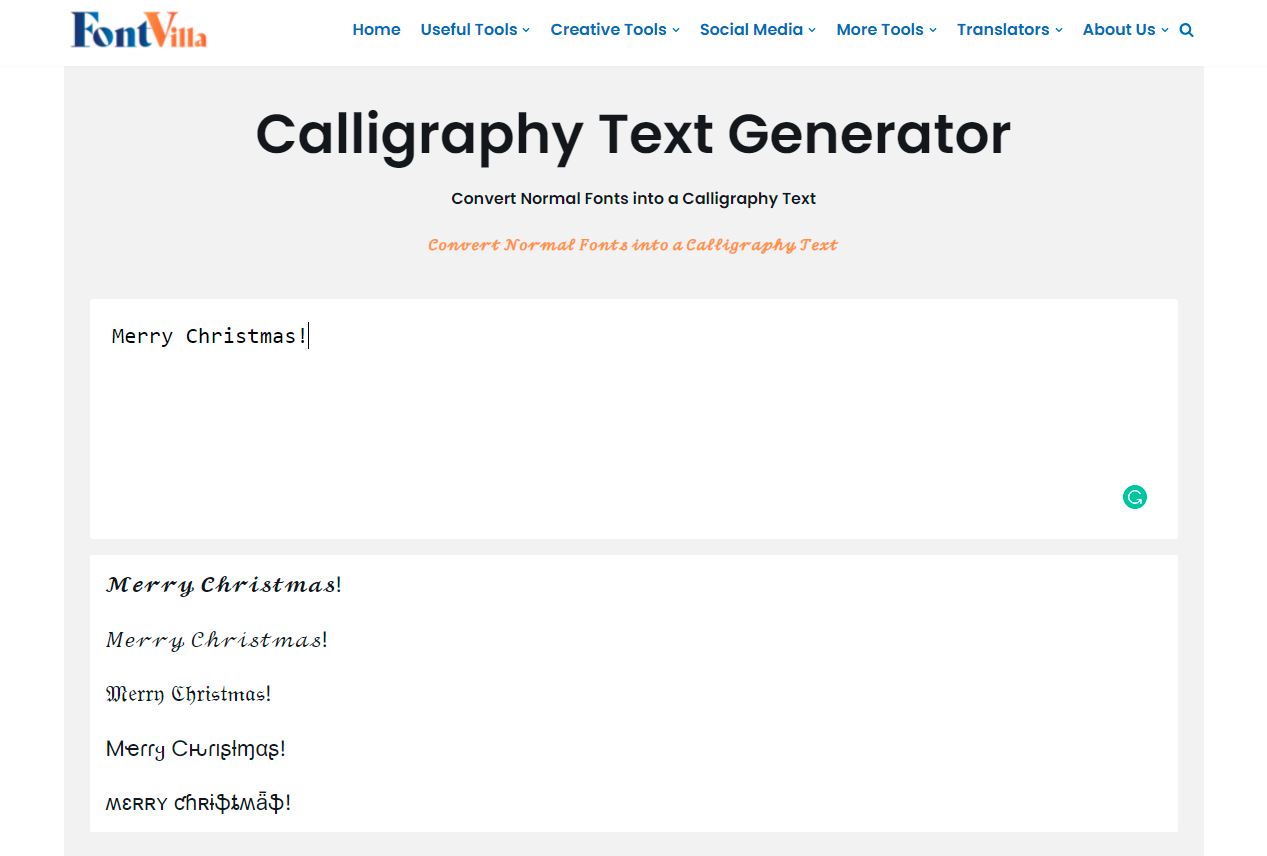
To wrap it all up:
- Type the text you want in Calligraphy Generator
- You will see fonts below
- Copy any font you want to use
- Paste it where you want and enjoy it
Who can use Calligraphy Letters Generator and where?
The fancy calligraphy font style generator can be used by different kinds of people for a large number of purposes. It can be used to add a unique and different touch to your social media posts such as those on Twitter, Instagram, Facebook, and Tumblr, etc.
Different calligraphy texts and alphabet can help your posts stand out and gain extra attention from your followers, friends, and your fan base considering that it adds an artsy touch to your text. The calligraphy maker will help users especially those who are social media personalities and/or influencers add a personal touch to their posts and content.
When one can add a more personal touch to their words by using a calligraphy font style, one is also able to express oneself better. Not only will the calligraphy text make your content more eye-catching, but it will also make it appear more personal, more expressive, something that may not be possible while using a standard, generic font that gets boring and monotonous after a while.
This can help you add more fun yet classy vibes to your content making it extremely unique. Other than that, you can also use this pretty font generator if you want the calligraphy-style text in software such as Adobe Photoshop or Gimp. What usually happens otherwise is that if you wish to use a particular font for software like Photoshop, you have to download that particular font.
With the calligraphy generator, you do not have to go through the hassle of downloading anything at all. Simply copy this font and paste any of the many available calligraphy style fonts directly into Photoshop. With the calligraphy converter, you can reduce the effort required to achieve the result, as well as make the experience more fun and efficient.
The text generated by this calligraphy font maker can also be used in web designing as well as by designers to add a unique, signature touch to their work.
Furthermore, several people out there also wish to get a tattoo in font styles that seem to be different and exotic to them. People, for this reason, love calligraphy style font to get that middle eastern, Arabic touch to their tattoos making it look vintage yet extremely cool. From writing letters, invitations, literature to digital art, the fancy calligraphy text and word generator is an extremely useful tool for people from all walks of life.
Recommended: Glitch Text Generator
- --> --> Text size --> -->